Trip Report:
Jaguars, Anteaters, and the Wildlife
of the South Pantanal
2012
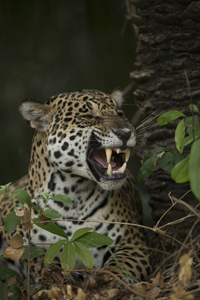
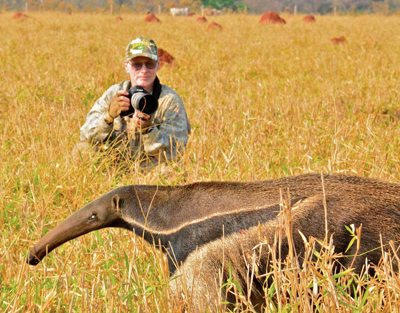
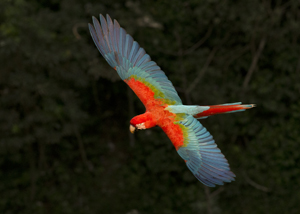
I've looked forward to visiting the southern Pantanal for years. I was told that the mammal opportunities were excellent, especially for Giant Anteaters. Our itinerary covered some of the 'tourist' activities, like the Fish Float, that I thought would be a waste of time but I was surprised -- I loved the float, and virtually all of the areas we visited. We succeeded in photographing everything we sought, including Ocelots and Giant Anteaters, and, as a huge surprise, the most cooperative Jaguar I've ever photographed! Here's the report:
Day 1. To Jardem
We left our lodge in the Pantanal by 8, arriving around noon at the Chiaba airport. A few hours later John, Frank, Doug, Richard, and Romaine headed home while Greg, Joe, Tom, Richard, and I waited another few hours for our flight. Our guide returned to help us through check-in, and thus we avoided an overcharge on a second, and heavy, piece of luggage.
At Campo Grande we were met by our new guide, Marcos, and we began our long 3 hour drive to our first destination. After a stop at a bakery/sandwich stop for a quick meal we continued, arriving around 11:15 at our hotel in Jardem.
Day 2. The Macaw sinkhole and Fish Float
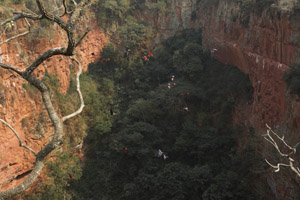
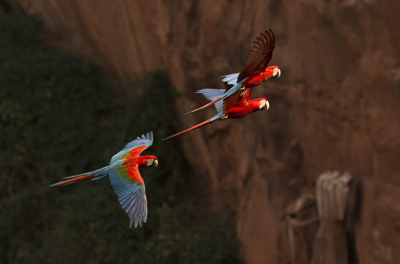
We left around 6:30 for the macaw sinkhole, a sanctuary on private land that has been turned into an ecotourism destination. Here as many as 50 pairs of Blue and Green Macaws nest, along with Buff-necked Ibis, and, in the area, a variety of other birds.
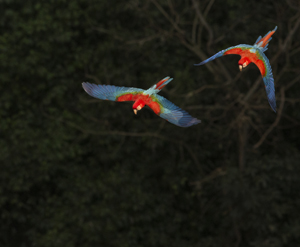 When we arrived a Macaw was perched on a bare limb quite close to the observation deck, giving us wonderful full-frame images, as well as wide-angle shots of the bird with the crater. Throughout the morning birds flew about, some flying low and toward our lookout, others circling about. At the first lookout two dead trees, perfect perch trees, interfere significantly with attempting to do flight shots, as birds inevitably pass behind the limbs, usually at the time of perfect focus. Later, with only twenty minutes left before we needed to head out, we tried the other lookout where, from the first one, the lighting didn’t look as favorable.
When we arrived a Macaw was perched on a bare limb quite close to the observation deck, giving us wonderful full-frame images, as well as wide-angle shots of the bird with the crater. Throughout the morning birds flew about, some flying low and toward our lookout, others circling about. At the first lookout two dead trees, perfect perch trees, interfere significantly with attempting to do flight shots, as birds inevitably pass behind the limbs, usually at the time of perfect focus. Later, with only twenty minutes left before we needed to head out, we tried the other lookout where, from the first one, the lighting didn’t look as favorable.
We were wrong, as the position would have been great from around 9:15 onward, and no trees or limbs obstructed the views of flying birds. Even with my new camera I missed focus a lot, as the trees or cliffs caught the focus sensor and not the birds. Nonetheless, in reviewing images later I did find a lot of successful shots.
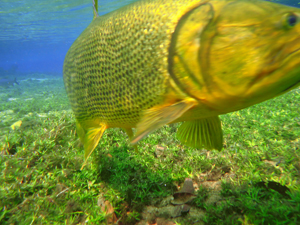 By 11 we were at the Posada for the fish float where we changed into shortie wetsuits, got masks, rented surprisingly good point-n-shoot cameras for $25, and did a three hour float down a clear stream amongst 50 different species of fish. Most of the time no swimming was required as we simply floated with the current, although this made trying to photograph difficult as we often sailed past fish before we could frame.
By 11 we were at the Posada for the fish float where we changed into shortie wetsuits, got masks, rented surprisingly good point-n-shoot cameras for $25, and did a three hour float down a clear stream amongst 50 different species of fish. Most of the time no swimming was required as we simply floated with the current, although this made trying to photograph difficult as we often sailed past fish before we could frame.
After the fish float and lunch we spent a bit of time around their bird feeders where peach-fronted parakeets and some parrots visited.
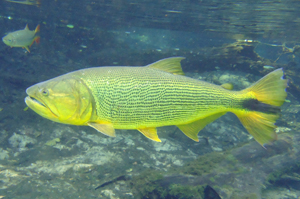

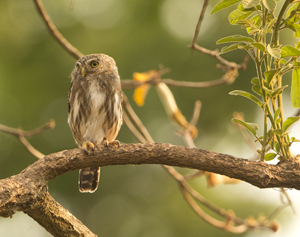
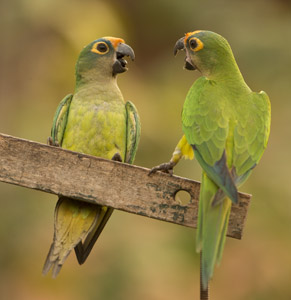
While we photographed, a Ferruginous Pigmy Owl flew in, giving me my first opportunity to photograph that bird in the Pantanal.
We spent the late afternoon and evening looking unsuccessfully for giant anteaters at a location where, until now, our guide has had one on every visit.
Day 3. To Posada Aguape Fazenda SP
We were supposed to have breakfast at 6:30 but I was awake at 5, into a schedule that can’t be broken. We left at 7, heading directly to our new lodge and dropping off Marcus, our guide for the last two days, at a spot where he could hitch-hike on to Bonito.
En route I spotted a Giant Anteater in a distant pasture. The animal is huge and dark, quite unmistakable with the long, vertically compressed fanned tail. We turned around and parked, and some of us had another brief view before it disappeared into a thicket and swamp.
Red-legged Seriemas are common in this country, and we saw several pairs of this African Secretarybird-look-alike, along with the South American equivalent of the ostrich, the Greater Rhea. We arrived at our new lodge by 11, settled into very nice rooms (the best yet of the trip), and photographed some of the birds and the 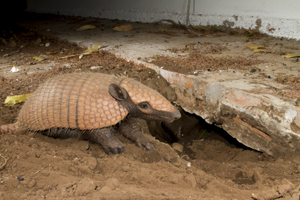 Yellow Armadillos that frequent the grounds. I set up another Range IR set, and had over 120 shots of two young armadillos coming out of their den.
Yellow Armadillos that frequent the grounds. I set up another Range IR set, and had over 120 shots of two young armadillos coming out of their den.
At 4 we all took horses to look for anteaters in the distant pastures, but the country is nothing like that where we scoped out yesterday, where hundreds of termite mounds dotted the land. We did see Pampas Deer (but not close), a new Macaw, and another Yellow Armadillo that I shot at ground-level.
After sunset we reached camp, just as a fierce wind blew in, threatening a rain that never came but spooking some of the horses. At dinner one of the armadillos scurries around the tables, and between the legs of the staff, who block it or push it away from entering the kitchen. The animal is tame and fearless.
Day 4. Posada Aguape
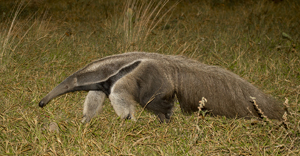
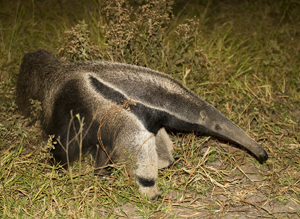
We met at 5AM to look for giant anteaters, and in the predawn we found one, galloping fast to reach the cover of the forest. Our vehicle pulled up to a fence and the gaucho got out, slipped through the fence, and started running. I figured that’s what we had to do and I was fast (slow) on his heels, but the anteater beat us to a small thicket. The gaucho worked around inside and the anteater broke out, running across the field with all of us trying to head it off and stop it. I did several shots basically on the fly, at ISO 2000 and with flash, while Tom, who forgot his flash, did what we hope our nice ambient light shots at ISO 10000. The anteater paused a few times but never reared up into a defensive position and, eventually, it just outran us.
This is not how I expected to see or work a Giant Anteater, but apparently they are skittish at this lodge and the encounters I assume only reinforce this. We returned for breakfast, and were treated with about 20 Toco Toucans at the ‘feeder tree,’ along with Black-headed Parakeets, two species of jays, and some blackbirds.
Tom and I had scheduled an hour flight-seeing where, at the half-way point, we’d stop at remote Barra Mansa Lodge. Richard, Greg, and Joe did a morning game drive and walk, but it turned out to be rather unproductive.
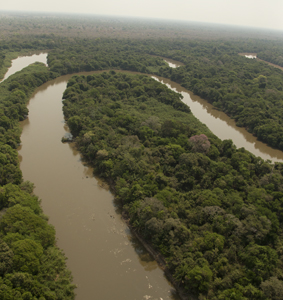
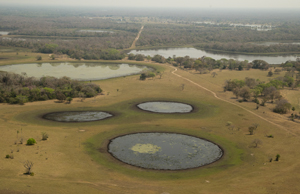
Our flight, in contrast, was a great deal of fun. We had both doors off of the Cessna, and trying to hold a camera in a 100mph wind was quite difficult, and gave me some idea of what enduring a hurricane must be like. I raised my ISO to 2000, shot wide-open, and had 1/8000th shutter speeds, so images should be sharp, despite the shake and buffeting. I’ve always wanted to fly over the Pantanal to get an aerial perspective, and to see the lay of the land, and here in the south, where numerous lagoons also dot the landscape, it was perfect.
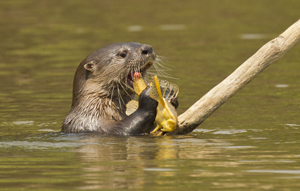 Barra Mansa Lodge was beautiful. The manager, Paulina, met us at the airfield and offered to give us a boat tour, although we were ready to decline she insisted, and I’m glad she did. We had two Neotropical Otters and, in contrast to the northern Pantanal, these were fairly tame. Oddly, their giant otters are quite timid, again the exact opposite to the north. One captured a catfish and fed upon a limb, giving us fairly decent shots with 300mm lenses.
Barra Mansa Lodge was beautiful. The manager, Paulina, met us at the airfield and offered to give us a boat tour, although we were ready to decline she insisted, and I’m glad she did. We had two Neotropical Otters and, in contrast to the northern Pantanal, these were fairly tame. Oddly, their giant otters are quite timid, again the exact opposite to the north. One captured a catfish and fed upon a limb, giving us fairly decent shots with 300mm lenses.
Further down river we encountered two White-lipped Peccary and one stayed by the shore, allowing us to slowly drift to almost frame-filling distance. Tom developed a cough just as we got the closest, and it was a bit comical to hear him try to 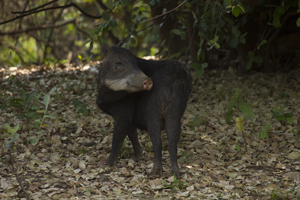 suppress his coughing. It probably actually helped, as it drew the peccary’s attention back to us.
suppress his coughing. It probably actually helped, as it drew the peccary’s attention back to us.
Two species live in the Pantanal, the other being the Collared Peccary we saw coming in to Aquape, and the same species found in our southwest – Texas to Arizona. The White-lipped is a bit rarer, more aggressive, and prone to travel in large groups, and I’ve only seen one small group, once, in my previous Pantanal trips.
Our boat ride took almost to noon, and we returned late to lunch, very satisfied with the boat trip and the flight, which cost 600 realis, or about $300 total, split two ways.
I set up another Range IR camera trap at the Armadillos, and again they were cooperative, yielding new perspectives with a different lens.
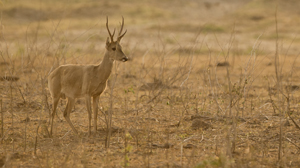
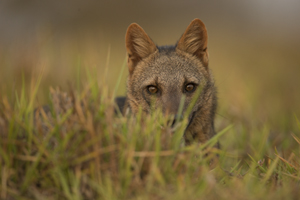
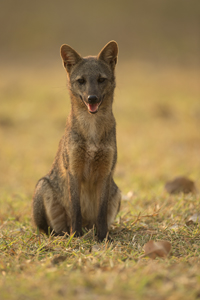 At 4 we headed into the western end of the property, covering much more interesting ground than we’d done previously. We stopped for another Yellow Armadillo, which spooked but paused at the edge of a thicket. A short time later we stopped for some Pampas Deer, and while we photographed a Crab-eating Fox trotted close to us. The lodge feeds the foxes, and they have associated the vehicle with food, so every time we stopped foxes showed up, and provided incredible late afternoon photography.
At 4 we headed into the western end of the property, covering much more interesting ground than we’d done previously. We stopped for another Yellow Armadillo, which spooked but paused at the edge of a thicket. A short time later we stopped for some Pampas Deer, and while we photographed a Crab-eating Fox trotted close to us. The lodge feeds the foxes, and they have associated the vehicle with food, so every time we stopped foxes showed up, and provided incredible late afternoon photography.
Our last stop of the day was at a Caiman pool where, as soon as we stopped, more than a dozen full adult Spectacled Caimans came ashore and crowed near our vehicle. We did multiple head shots before the gauchos started tossing some fish, which the caimans lunged at, providing quite a show.
As we left we spotted an Ocelot, but it didn’t come close and only Tom managed one distant shot as it walked away. We did have another Giant Anteater as well, but it too was skittish and although we followed it for ten minutes or so we never got close. With the dust in the air photography would have been impossible with the dust back-scatter.
Tomorrow morning we’ll try again, early, for more anteaters, but I did enjoy the diversity of activities – horseback, plane, and various long crepuscular game-drives, here at this lodge.
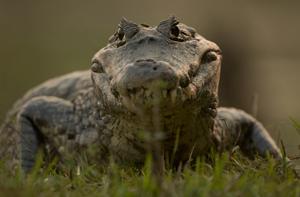
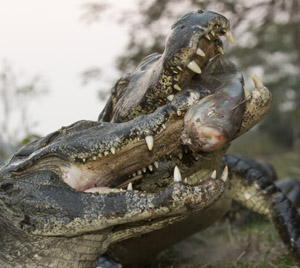
Day 5. Aquape Lodge to San Francisco Lodge
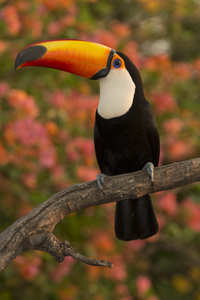
We did another drive for anteaters, covering much of the same territory we did yesterday afternoon. We saw none, and although we were prepared for the caimans with wide-angle lenses, we discovered that in the cool of a morning the caimans retreat and are hidden in the pond. There was no indication that this pool had twenty or more large caimans, as we saw the heads of less than five.
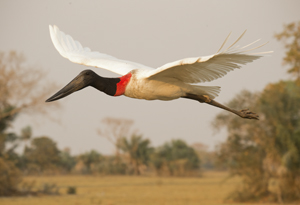 As we returned to camp a pair of Jabiru Storks joined us, apparently looking for a handout. We’d drive along and the birds would suddenly take off and fly to us, landing just a short distance ahead. Once we understood what was happening we started photographing, driving to a clear spot, stopping the truck, and waving, and within seconds the storks would take off and join us. We did this multiple times until the birds, unrewarded for all the effort, eventually flew passed us and continued over the forest.
As we returned to camp a pair of Jabiru Storks joined us, apparently looking for a handout. We’d drive along and the birds would suddenly take off and fly to us, landing just a short distance ahead. Once we understood what was happening we started photographing, driving to a clear spot, stopping the truck, and waving, and within seconds the storks would take off and join us. We did this multiple times until the birds, unrewarded for all the effort, eventually flew passed us and continued over the forest.
We left at 8 for San Francisco lodge, dropping our female guide off along the highway where she would hitch-hike back home. In many ways Brazil reminds me of what I suppose rural America was like in the 1950s, when hitch-hiking was common and safe. En route, I bought a gaucho machete and sharpener – handy for clearing brush at home. We hadn't traveled far from the lodge when we encountered a cattle drive with four gaucho cowboys driving the distinctive white cows of the Pantanal down the dirt road. They passed close by, and we filmed with a variety of lenses.
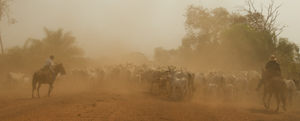
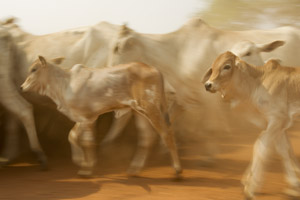 We arrived at SFL at lunch, and went through off-putting paperwork of disclaimers, before eating and going to our rooms. Here, perhaps because of the traffic of people that move through, everything is official and regimented and impersonal, and my initial impression was that I hated it. Our guide did not appear until shortly before our afternoon excursion, reinforcing to me the thought that we’re just meat going through the system.
We arrived at SFL at lunch, and went through off-putting paperwork of disclaimers, before eating and going to our rooms. Here, perhaps because of the traffic of people that move through, everything is official and regimented and impersonal, and my initial impression was that I hated it. Our guide did not appear until shortly before our afternoon excursion, reinforcing to me the thought that we’re just meat going through the system.
Nonetheless, we do have a good guide and he has proven helpful, if often absent. At 2 we did a boat trip down a broad lagoon-like river where, yesterday, a jaguar was spotted for 50 minutes. Today was tame, and the highlight was probably fishing for Piranha fish with cane poles. Miraculously, I caught one, which we returned to the river.
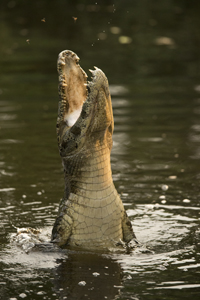 Later we tossed some fish for the Black-collared Hawks, and teased a Caiman with another fish held overhead via a rod. Like Aussie crocs, the caimans would lunge out of the water to grab the fish but always too late to succeed. Caimans, like all crocs, are great lateral snapping predators, and when a fish was dropped alongside it was instantly snatched.
Later we tossed some fish for the Black-collared Hawks, and teased a Caiman with another fish held overhead via a rod. Like Aussie crocs, the caimans would lunge out of the water to grab the fish but always too late to succeed. Caimans, like all crocs, are great lateral snapping predators, and when a fish was dropped alongside it was instantly snatched.
At 7:30 we drove the tracks through the rice fields hoping for an Ocelot. We found one, and it was a bit easier to shoot than those I’ve had in the northern Pantanal, although we all are hoping for an even better one tonight. At the end of the drive we had a cooperative Striped Owl perched on a tree tip. The owl looks quite like our long-eared owls.
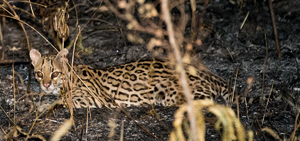
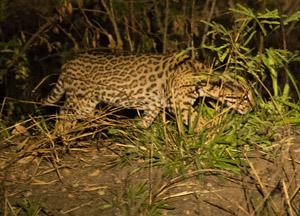
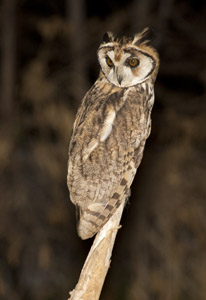
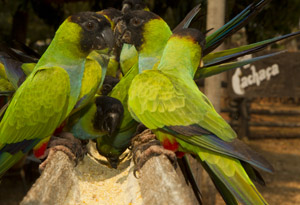
Day 6. SFL
We met at 5:30 for a private ($250) vehicle tour and headed directly for Giant Anteaters. We traveled less than a mile when our guide stopped us, having spotted three in the fields before us. For the next three hours we worked three different 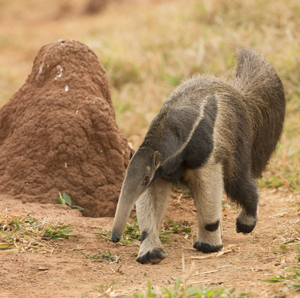 anteaters, first by approaching carefully downwind but eventually requiring not much more than simply staying a minimum distance away. At times a 500mm was much too tight, although Greg and I were ready with our big lenses when one anteater walked down a game trail towards us, completely in the open. Later, when I was the last still in the field, another anteater headed towards the forest for the day and I positioned myself on a trail, but I found it was the wrong one and the anteater walked passed at a distance and I missed that shot.
anteaters, first by approaching carefully downwind but eventually requiring not much more than simply staying a minimum distance away. At times a 500mm was much too tight, although Greg and I were ready with our big lenses when one anteater walked down a game trail towards us, completely in the open. Later, when I was the last still in the field, another anteater headed towards the forest for the day and I positioned myself on a trail, but I found it was the wrong one and the anteater walked passed at a distance and I missed that shot.
I was surprised to find that the anteaters rarely tore at the termite mounds. Instead, they watch or smell for the pencil-thick holes in the earth created by foraging termites. No digging is involved in feeding here, as the tongue can go in, stick a couple of huge termites, and either go on or do another few bouts of termite grazing. I was surprised at the size of the termites, which were about as long and half as thick as the fingernail of my little finger. A couple of handfuls of these termites would be easy to gather with the right tools (like an anteater tongue) and would fill up an anteater quickly.
We returned to the lodge in time for a late breakfast. Afterwards, I used my wireless remote to photograph Black-hooded Parakeets feeding at a trough. I used two lenses – 16-35 and 24-105, with flash, and hopefully got something out of it all.
At 3 we went out on a long, fast boat with a covered canopy. While the shade is nice the struts supporting it, and the handrails, seemed to always be in the way for any images. The river flows south in a gradually winding course with banks that are ten feet or more in height – in thinking about the rainy season it is hard to imagine the volume and scope of the water present. The river bank was rather devoid of capybara and caiman, although at night the picture is probably different, but again it points to the abundance of game, and hence jaguars, in the Joffre area. Aside from a good Crane Hawk feeding upon a frog, and some distant Howler Monkeys, the ride, while pleasant, was unexceptional.
After dinner we did another Night Game Drive. Our spotter had a brief glimpse of two jaguars but we missed them and they stayed in thick cover. We had a very close Striped Owl, but as this was one of the first things spotted the crowd was noisy and the bird flew to a more distant tree. We passed by one fire area and the spot light’s cone of light was thick with smoke. Shortly after, we found another Ocelot which stayed in the open for a few minutes but disappeared into thick cover.
Day 7. SFL
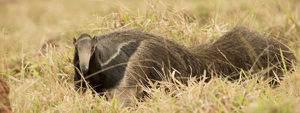 We left at 5:30 again for Giant Anteaters and were immediately successful, right out of the gate. The lodge gave us an early out vehicle, rather than the charge from yesterday since we put on less than a mile of travel. I’d planned on walking out but it was nice to be driven, even if it was only a mile or less, significant when carrying big lenses.
We left at 5:30 again for Giant Anteaters and were immediately successful, right out of the gate. The lodge gave us an early out vehicle, rather than the charge from yesterday since we put on less than a mile of travel. I’d planned on walking out but it was nice to be driven, even if it was only a mile or less, significant when carrying big lenses.
We stayed with the Giant Anteater for over 2.5 hours as it covered the length of a field, giving us some very close views and in the open with little grass. We spotted another in the distance but that one soon disappeared. Eventually ‘our’ anteater pushed itself through a fence and Greg and I climbed over and followed, and here I just used my 70-300 and hand-held, and got close. Some of the best poses, unfortunately, had our other shooters in the background, all lined up taking shots of me and the anteater. Nonetheless, this does provide some perspective as to distance.
Giant Anteaters are said to have been seen in death in the dead embrace of a jaguar. Supposedly jaguars have attacked anteaters which then envelope the jaguar in its powerful arms and kill it, while the jaguars is doing the same in its way to the anteater. Watching the anteaters over the last two days, I’m struck by their almost complete lack of alertness. We had to approach downwind to avoid being scented, although at the end of the day I was upwind of our subject and the anteater quite audibly snort/sniffed by presence. Occasionally as we moved about the anteater would raise its head and freeze, as if trying to make us out, and it did a similar pose when it heard loud voices. However, had I been a jaguar or a puma and been stalking it, I’d have been within pouncing range quite easily.
Yet the anteaters do not display any of the alert feeding behaviors one would expect of a potential prey animal. I had the impression it had little to fear. Perhaps its flesh is not very palatable from its diet of ants and termites, although I doubt if that would stop a starving big cat. Instead, I think that even with a killing bite to the neck, an anteater might still have time to bring one of its forelegs/paws up to its shoulder and, with those incredibly large and sharp claws at the end of immense arms and shoulders, rip and severely damage any predator. Perhaps they don’t do a bear hug, but I imagine they could still do damage with a slash.
Tamanduas, or lesser anteaters, more frequently employ the defensive pose both are capable of doing, and that is standing on their hind legs, arms outstretched in a flair as they face an attacker. One researcher I met told me of a worker who had his calf literally ripped from his leg when he got too close to a tamandua in its defensive display. I imagine a giant anteater’s blow would be even more devastating.
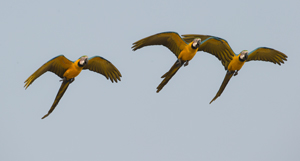 At 11 today we had a jaguar lecture from a researcher who has spent the last 10 years working at this ranch and with jaguar research. His talk answered some questions I had. He believes the gene for black, or melanism, is dominant, and that 60% of the jaguars of the Amazon are black. I’ve always assumed that the gene was recessive, or hidden, and therefore could be expressed at any time when two adults, with ‘hidden’ genes mated. This would account for a black jaguar appearing elsewhere, just as a black leopard could appear in the Mara or Serengeti, as adults with that gene could travel, mate, and pass on the recessive without it being expressed until a chance mating. However, it makes perfect sense as a dominant gene, as it would be immediately expressed with an offspring carrying that gene, and would then be selected against, or eliminated, if a black jaguar or leopard ventured into the open areas of the Pantanal or the Mara, for leopards.
At 11 today we had a jaguar lecture from a researcher who has spent the last 10 years working at this ranch and with jaguar research. His talk answered some questions I had. He believes the gene for black, or melanism, is dominant, and that 60% of the jaguars of the Amazon are black. I’ve always assumed that the gene was recessive, or hidden, and therefore could be expressed at any time when two adults, with ‘hidden’ genes mated. This would account for a black jaguar appearing elsewhere, just as a black leopard could appear in the Mara or Serengeti, as adults with that gene could travel, mate, and pass on the recessive without it being expressed until a chance mating. However, it makes perfect sense as a dominant gene, as it would be immediately expressed with an offspring carrying that gene, and would then be selected against, or eliminated, if a black jaguar or leopard ventured into the open areas of the Pantanal or the Mara, for leopards.
Jaguars are blamed for cattle deaths in the Pantanal, regardless of causes. On this ranch, where mortality is monitored, of the 3,000-4,000 cattle on the ranch, less than .5 percent, a half percent, are killed by jaguars. This is probably the same for other areas as well.
Nonetheless, ranchers are still killing jaguars, and although few probably employ their own, ranch-based jaguar hunter, there are hunters available. Our lecturer demonstrated a 'jaguar caller,' a length of a palm trunk with a leather drum stretched across the bottom. Another strip of leather poked through the drum, and by rubbing a damp leather cloth up along the strip one can produce a deep, resonate grunt or roar, quite like that of a jaguar. I've heard of this caller previously, although it was described as a gourd, but this was the first time I had a chance to see one demonstrated, or to play the caller myself.
He believes, as I do, that jaguars do not migrate out of their territories to higher ground outside their range during the wet season. Instead, they probably frequent known high ground on their range, even if that is still covered with several inches of water. To rest or sleep, jaguars could take to the trees. He cited the Amazon basin where thousands of square miles are flooded, and where it would be impossible for jaguars to migrate to new areas during the wet season. Those cats must use the trees, and probably hunt there for monkeys and sloths, as well as their now semi-aquatic prey below. Those jaguars weigh about half that of the Pantanal cats.
Pumas are less frequently seen and on this ranch have extremely small ranges – just a few acres in extent. Some sexually mature females weigh only 22 kilos, while males may go 40, again almost half the weight of a US puma. Large male Ocelots, in contrast, may weigh 16 kilos, nearly as much as a female puma. Skins on their museum wall, and old photos of shot ocelots, confirm these cats can be big!
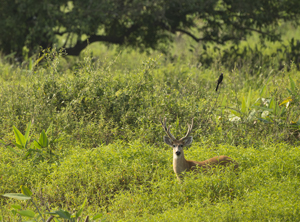 On this ranch there are about 10 jaguars in the range. The ranch is known for its ocelots, and the rice fields attracting rats was the reason I’d been given. The biologist agreed with me, however, in that rice had nothing to do with it. Instead, the rice wetlands and the numerous connection roads and dikes have created multiple and extensive edge habitat, and with all the roads going through that habitat one sees ocelots more frequently. If the northern Pantanal had as much water, and roads bordering the ponds, it is quite likely we’d be seeing as many ocelots there.
On this ranch there are about 10 jaguars in the range. The ranch is known for its ocelots, and the rice fields attracting rats was the reason I’d been given. The biologist agreed with me, however, in that rice had nothing to do with it. Instead, the rice wetlands and the numerous connection roads and dikes have created multiple and extensive edge habitat, and with all the roads going through that habitat one sees ocelots more frequently. If the northern Pantanal had as much water, and roads bordering the ponds, it is quite likely we’d be seeing as many ocelots there.
In the afternoon we left at 2:30, given the option of the big tour boat, where we could have repeated the caiman jumps, piranha fishing, and hawk swoop, or the faster smaller boat where we could explore more of the river and travel farther. Luckily, I chose the latter.
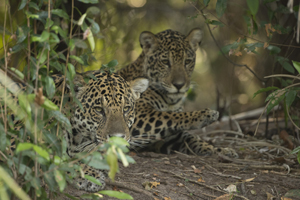
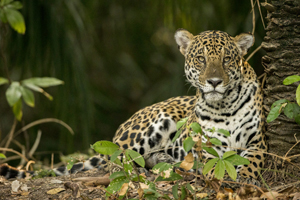
We hadn’t traveled far when our guide received a radio call that the big tour boat guide had spotted a jaguar. We did a quick U-turn and headed back, and within minutes we were with what turned out to be two cats – a mother and a 9 month old cub. Both had moved downstream but settled into a clearing where I spotted them and the cats were fairly oblivious to us as we moved in closer. With all of us 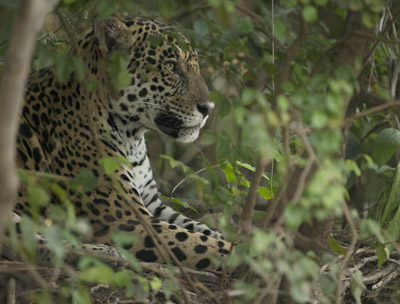 in one long boat getting the right angle for everyone was a bit of a problem but our guide paddled back and forth, giving all a good window. Eventually the jaguars moved, but the female settled into another very clear spot with, unfortunately, a narrow window.
in one long boat getting the right angle for everyone was a bit of a problem but our guide paddled back and forth, giving all a good window. Eventually the jaguars moved, but the female settled into another very clear spot with, unfortunately, a narrow window.
Nonetheless, this was the most cooperative and tolerant jaguar I’ve ever photographed. At our closest we were 22 feet from the film plane, and the distance looked even closer than that. The cat alternated between sleeping, staring off, or looking directly at us but without malice. It was an incredible experience and the best portrait session I’ve ever had.
My initial feelings about SFL were a bit harsh, probably because of the officious check-in and drink-taking procedure, but for wildlife, it delivered. We had our incredible two jaguars, two ocelots at one per night (I opted out, as did everyone else, for our last night of game driving in order to pack), eight different Giant Anteaters, good Greater Rheas, and several parrots, along with the water birds we’ve had elsewhere.
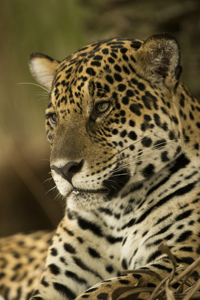 We were scheduled to do another night game drive, but only the 'other' Joe in our group had the energy to go. I needed to pack and back up images (although I've only culled out obvious bad shots, I had 400 gb of images to cull for my final edit!). Joe did great, seeing FOUR Ocelots in a 1.5 hour game drive, with two ocelots coming extremely close to the vehicle! He was thrilled.
We were scheduled to do another night game drive, but only the 'other' Joe in our group had the energy to go. I needed to pack and back up images (although I've only culled out obvious bad shots, I had 400 gb of images to cull for my final edit!). Joe did great, seeing FOUR Ocelots in a 1.5 hour game drive, with two ocelots coming extremely close to the vehicle! He was thrilled.
The southern Pantanal proved to be great, with over-all better accommodations and better food (by far) than the north, and a greater variety of activities and wildlife. The break at Aquape where we horse back rode, our air plane tour, and the boat ride down the other lodge’s river all were fun and memorable, and the shooting quite good. The scouting trip was a success, and we will be returning to the South, either as an extension or even a full tour.
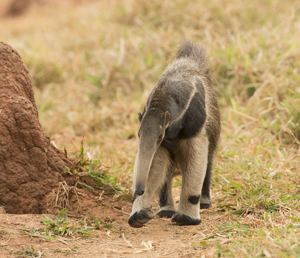
Read about our Jaguars and the Wildlife of the Pantanal trips
One or Two for 2012
Refer to our 2012 BROCHURE to get an idea of next year's trip!
Visit our Trip and Scouting Report Pages for more images and an even better idea of what our trips to the Pantanal are like. There you'll find our archived reports from previous years.
Trip Report:
Jaguars, Anteaters, and the Wildlife
of the South Pantanal
2012



I've looked forward to visiting the southern Pantanal for years. I was told that the mammal opportunities were excellent, especially for Giant Anteaters. Our itinerary covered some of the 'tourist' activities, like the Fish Float, that I thought would be a waste of time but I was surprised -- I loved the float, and virtually all of the areas we visited. We succeeded in photographing everything we sought, including Ocelots and Giant Anteaters, and, as a huge surprise, the most cooperative Jaguar I've ever photographed! Here's the report:
Day 1. To Jardem
We left our lodge in the Pantanal by 8, arriving around noon at the Chiaba airport. A few hours later John, Frank, Doug, Richard, and Romaine headed home while Greg, Joe, Tom, Richard, and I waited another few hours for our flight. Our guide returned to help us through check-in, and thus we avoided an overcharge on a second, and heavy, piece of luggage.
At Campo Grande we were met by our new guide, Marcos, and we began our long 3 hour drive to our first destination. After a stop at a bakery/sandwich stop for a quick meal we continued, arriving around 11:15 at our hotel in Jardem.
Day 2. The Macaw sinkhole and Fish Float


We left around 6:30 for the macaw sinkhole, a sanctuary on private land that has been turned into an ecotourism destination. Here as many as 50 pairs of Blue and Green Macaws nest, along with Buff-necked Ibis, and, in the area, a variety of other birds.
 When we arrived a Macaw was perched on a bare limb quite close to the observation deck, giving us wonderful full-frame images, as well as wide-angle shots of the bird with the crater. Throughout the morning birds flew about, some flying low and toward our lookout, others circling about. At the first lookout two dead trees, perfect perch trees, interfere significantly with attempting to do flight shots, as birds inevitably pass behind the limbs, usually at the time of perfect focus. Later, with only twenty minutes left before we needed to head out, we tried the other lookout where, from the first one, the lighting didn’t look as favorable.
When we arrived a Macaw was perched on a bare limb quite close to the observation deck, giving us wonderful full-frame images, as well as wide-angle shots of the bird with the crater. Throughout the morning birds flew about, some flying low and toward our lookout, others circling about. At the first lookout two dead trees, perfect perch trees, interfere significantly with attempting to do flight shots, as birds inevitably pass behind the limbs, usually at the time of perfect focus. Later, with only twenty minutes left before we needed to head out, we tried the other lookout where, from the first one, the lighting didn’t look as favorable.
We were wrong, as the position would have been great from around 9:15 onward, and no trees or limbs obstructed the views of flying birds. Even with my new camera I missed focus a lot, as the trees or cliffs caught the focus sensor and not the birds. Nonetheless, in reviewing images later I did find a lot of successful shots.
 By 11 we were at the Posada for the fish float where we changed into shortie wetsuits, got masks, rented surprisingly good point-n-shoot cameras for $25, and did a three hour float down a clear stream amongst 50 different species of fish. Most of the time no swimming was required as we simply floated with the current, although this made trying to photograph difficult as we often sailed past fish before we could frame.
By 11 we were at the Posada for the fish float where we changed into shortie wetsuits, got masks, rented surprisingly good point-n-shoot cameras for $25, and did a three hour float down a clear stream amongst 50 different species of fish. Most of the time no swimming was required as we simply floated with the current, although this made trying to photograph difficult as we often sailed past fish before we could frame.
After the fish float and lunch we spent a bit of time around their bird feeders where peach-fronted parakeets and some parrots visited.




While we photographed, a Ferruginous Pigmy Owl flew in, giving me my first opportunity to photograph that bird in the Pantanal.
We spent the late afternoon and evening looking unsuccessfully for giant anteaters at a location where, until now, our guide has had one on every visit.
Day 3. To Posada Aguape Fazenda SP
We were supposed to have breakfast at 6:30 but I was awake at 5, into a schedule that can’t be broken. We left at 7, heading directly to our new lodge and dropping off Marcus, our guide for the last two days, at a spot where he could hitch-hike on to Bonito.
En route I spotted a Giant Anteater in a distant pasture. The animal is huge and dark, quite unmistakable with the long, vertically compressed fanned tail. We turned around and parked, and some of us had another brief view before it disappeared into a thicket and swamp.
Red-legged Seriemas are common in this country, and we saw several pairs of this African Secretarybird-look-alike, along with the South American equivalent of the ostrich, the Greater Rhea. We arrived at our new lodge by 11, settled into very nice rooms (the best yet of the trip), and photographed some of the birds and the  Yellow Armadillos that frequent the grounds. I set up another Range IR set, and had over 120 shots of two young armadillos coming out of their den.
Yellow Armadillos that frequent the grounds. I set up another Range IR set, and had over 120 shots of two young armadillos coming out of their den.
At 4 we all took horses to look for anteaters in the distant pastures, but the country is nothing like that where we scoped out yesterday, where hundreds of termite mounds dotted the land. We did see Pampas Deer (but not close), a new Macaw, and another Yellow Armadillo that I shot at ground-level.
After sunset we reached camp, just as a fierce wind blew in, threatening a rain that never came but spooking some of the horses. At dinner one of the armadillos scurries around the tables, and between the legs of the staff, who block it or push it away from entering the kitchen. The animal is tame and fearless.
Day 4. Posada Aguape


We met at 5AM to look for giant anteaters, and in the predawn we found one, galloping fast to reach the cover of the forest. Our vehicle pulled up to a fence and the gaucho got out, slipped through the fence, and started running. I figured that’s what we had to do and I was fast (slow) on his heels, but the anteater beat us to a small thicket. The gaucho worked around inside and the anteater broke out, running across the field with all of us trying to head it off and stop it. I did several shots basically on the fly, at ISO 2000 and with flash, while Tom, who forgot his flash, did what we hope our nice ambient light shots at ISO 10000. The anteater paused a few times but never reared up into a defensive position and, eventually, it just outran us.
This is not how I expected to see or work a Giant Anteater, but apparently they are skittish at this lodge and the encounters I assume only reinforce this. We returned for breakfast, and were treated with about 20 Toco Toucans at the ‘feeder tree,’ along with Black-headed Parakeets, two species of jays, and some blackbirds.
Tom and I had scheduled an hour flight-seeing where, at the half-way point, we’d stop at remote Barra Mansa Lodge. Richard, Greg, and Joe did a morning game drive and walk, but it turned out to be rather unproductive.


Our flight, in contrast, was a great deal of fun. We had both doors off of the Cessna, and trying to hold a camera in a 100mph wind was quite difficult, and gave me some idea of what enduring a hurricane must be like. I raised my ISO to 2000, shot wide-open, and had 1/8000th shutter speeds, so images should be sharp, despite the shake and buffeting. I’ve always wanted to fly over the Pantanal to get an aerial perspective, and to see the lay of the land, and here in the south, where numerous lagoons also dot the landscape, it was perfect.
 Barra Mansa Lodge was beautiful. The manager, Paulina, met us at the airfield and offered to give us a boat tour, although we were ready to decline she insisted, and I’m glad she did. We had two Neotropical Otters and, in contrast to the northern Pantanal, these were fairly tame. Oddly, their giant otters are quite timid, again the exact opposite to the north. One captured a catfish and fed upon a limb, giving us fairly decent shots with 300mm lenses.
Barra Mansa Lodge was beautiful. The manager, Paulina, met us at the airfield and offered to give us a boat tour, although we were ready to decline she insisted, and I’m glad she did. We had two Neotropical Otters and, in contrast to the northern Pantanal, these were fairly tame. Oddly, their giant otters are quite timid, again the exact opposite to the north. One captured a catfish and fed upon a limb, giving us fairly decent shots with 300mm lenses.
Further down river we encountered two White-lipped Peccary and one stayed by the shore, allowing us to slowly drift to almost frame-filling distance. Tom developed a cough just as we got the closest, and it was a bit comical to hear him try to  suppress his coughing. It probably actually helped, as it drew the peccary’s attention back to us.
suppress his coughing. It probably actually helped, as it drew the peccary’s attention back to us.
Two species live in the Pantanal, the other being the Collared Peccary we saw coming in to Aquape, and the same species found in our southwest – Texas to Arizona. The White-lipped is a bit rarer, more aggressive, and prone to travel in large groups, and I’ve only seen one small group, once, in my previous Pantanal trips.
Our boat ride took almost to noon, and we returned late to lunch, very satisfied with the boat trip and the flight, which cost 600 realis, or about $300 total, split two ways.
I set up another Range IR camera trap at the Armadillos, and again they were cooperative, yielding new perspectives with a different lens.


 At 4 we headed into the western end of the property, covering much more interesting ground than we’d done previously. We stopped for another Yellow Armadillo, which spooked but paused at the edge of a thicket. A short time later we stopped for some Pampas Deer, and while we photographed a Crab-eating Fox trotted close to us. The lodge feeds the foxes, and they have associated the vehicle with food, so every time we stopped foxes showed up, and provided incredible late afternoon photography.
At 4 we headed into the western end of the property, covering much more interesting ground than we’d done previously. We stopped for another Yellow Armadillo, which spooked but paused at the edge of a thicket. A short time later we stopped for some Pampas Deer, and while we photographed a Crab-eating Fox trotted close to us. The lodge feeds the foxes, and they have associated the vehicle with food, so every time we stopped foxes showed up, and provided incredible late afternoon photography.
Our last stop of the day was at a Caiman pool where, as soon as we stopped, more than a dozen full adult Spectacled Caimans came ashore and crowed near our vehicle. We did multiple head shots before the gauchos started tossing some fish, which the caimans lunged at, providing quite a show.
As we left we spotted an Ocelot, but it didn’t come close and only Tom managed one distant shot as it walked away. We did have another Giant Anteater as well, but it too was skittish and although we followed it for ten minutes or so we never got close. With the dust in the air photography would have been impossible with the dust back-scatter.
Tomorrow morning we’ll try again, early, for more anteaters, but I did enjoy the diversity of activities – horseback, plane, and various long crepuscular game-drives, here at this lodge.


Day 5. Aquape Lodge to San Francisco Lodge

We did another drive for anteaters, covering much of the same territory we did yesterday afternoon. We saw none, and although we were prepared for the caimans with wide-angle lenses, we discovered that in the cool of a morning the caimans retreat and are hidden in the pond. There was no indication that this pool had twenty or more large caimans, as we saw the heads of less than five.
 As we returned to camp a pair of Jabiru Storks joined us, apparently looking for a handout. We’d drive along and the birds would suddenly take off and fly to us, landing just a short distance ahead. Once we understood what was happening we started photographing, driving to a clear spot, stopping the truck, and waving, and within seconds the storks would take off and join us. We did this multiple times until the birds, unrewarded for all the effort, eventually flew passed us and continued over the forest.
As we returned to camp a pair of Jabiru Storks joined us, apparently looking for a handout. We’d drive along and the birds would suddenly take off and fly to us, landing just a short distance ahead. Once we understood what was happening we started photographing, driving to a clear spot, stopping the truck, and waving, and within seconds the storks would take off and join us. We did this multiple times until the birds, unrewarded for all the effort, eventually flew passed us and continued over the forest.
We left at 8 for San Francisco lodge, dropping our female guide off along the highway where she would hitch-hike back home. In many ways Brazil reminds me of what I suppose rural America was like in the 1950s, when hitch-hiking was common and safe. En route, I bought a gaucho machete and sharpener – handy for clearing brush at home. We hadn't traveled far from the lodge when we encountered a cattle drive with four gaucho cowboys driving the distinctive white cows of the Pantanal down the dirt road. They passed close by, and we filmed with a variety of lenses.

 We arrived at SFL at lunch, and went through off-putting paperwork of disclaimers, before eating and going to our rooms. Here, perhaps because of the traffic of people that move through, everything is official and regimented and impersonal, and my initial impression was that I hated it. Our guide did not appear until shortly before our afternoon excursion, reinforcing to me the thought that we’re just meat going through the system.
We arrived at SFL at lunch, and went through off-putting paperwork of disclaimers, before eating and going to our rooms. Here, perhaps because of the traffic of people that move through, everything is official and regimented and impersonal, and my initial impression was that I hated it. Our guide did not appear until shortly before our afternoon excursion, reinforcing to me the thought that we’re just meat going through the system.
Nonetheless, we do have a good guide and he has proven helpful, if often absent. At 2 we did a boat trip down a broad lagoon-like river where, yesterday, a jaguar was spotted for 50 minutes. Today was tame, and the highlight was probably fishing for Piranha fish with cane poles. Miraculously, I caught one, which we returned to the river.
 Later we tossed some fish for the Black-collared Hawks, and teased a Caiman with another fish held overhead via a rod. Like Aussie crocs, the caimans would lunge out of the water to grab the fish but always too late to succeed. Caimans, like all crocs, are great lateral snapping predators, and when a fish was dropped alongside it was instantly snatched.
Later we tossed some fish for the Black-collared Hawks, and teased a Caiman with another fish held overhead via a rod. Like Aussie crocs, the caimans would lunge out of the water to grab the fish but always too late to succeed. Caimans, like all crocs, are great lateral snapping predators, and when a fish was dropped alongside it was instantly snatched.
At 7:30 we drove the tracks through the rice fields hoping for an Ocelot. We found one, and it was a bit easier to shoot than those I’ve had in the northern Pantanal, although we all are hoping for an even better one tonight. At the end of the drive we had a cooperative Striped Owl perched on a tree tip. The owl looks quite like our long-eared owls.




Day 6. SFL
We met at 5:30 for a private ($250) vehicle tour and headed directly for Giant Anteaters. We traveled less than a mile when our guide stopped us, having spotted three in the fields before us. For the next three hours we worked three different  anteaters, first by approaching carefully downwind but eventually requiring not much more than simply staying a minimum distance away. At times a 500mm was much too tight, although Greg and I were ready with our big lenses when one anteater walked down a game trail towards us, completely in the open. Later, when I was the last still in the field, another anteater headed towards the forest for the day and I positioned myself on a trail, but I found it was the wrong one and the anteater walked passed at a distance and I missed that shot.
anteaters, first by approaching carefully downwind but eventually requiring not much more than simply staying a minimum distance away. At times a 500mm was much too tight, although Greg and I were ready with our big lenses when one anteater walked down a game trail towards us, completely in the open. Later, when I was the last still in the field, another anteater headed towards the forest for the day and I positioned myself on a trail, but I found it was the wrong one and the anteater walked passed at a distance and I missed that shot.
I was surprised to find that the anteaters rarely tore at the termite mounds. Instead, they watch or smell for the pencil-thick holes in the earth created by foraging termites. No digging is involved in feeding here, as the tongue can go in, stick a couple of huge termites, and either go on or do another few bouts of termite grazing. I was surprised at the size of the termites, which were about as long and half as thick as the fingernail of my little finger. A couple of handfuls of these termites would be easy to gather with the right tools (like an anteater tongue) and would fill up an anteater quickly.
We returned to the lodge in time for a late breakfast. Afterwards, I used my wireless remote to photograph Black-hooded Parakeets feeding at a trough. I used two lenses – 16-35 and 24-105, with flash, and hopefully got something out of it all.
At 3 we went out on a long, fast boat with a covered canopy. While the shade is nice the struts supporting it, and the handrails, seemed to always be in the way for any images. The river flows south in a gradually winding course with banks that are ten feet or more in height – in thinking about the rainy season it is hard to imagine the volume and scope of the water present. The river bank was rather devoid of capybara and caiman, although at night the picture is probably different, but again it points to the abundance of game, and hence jaguars, in the Joffre area. Aside from a good Crane Hawk feeding upon a frog, and some distant Howler Monkeys, the ride, while pleasant, was unexceptional.
After dinner we did another Night Game Drive. Our spotter had a brief glimpse of two jaguars but we missed them and they stayed in thick cover. We had a very close Striped Owl, but as this was one of the first things spotted the crowd was noisy and the bird flew to a more distant tree. We passed by one fire area and the spot light’s cone of light was thick with smoke. Shortly after, we found another Ocelot which stayed in the open for a few minutes but disappeared into thick cover.
Day 7. SFL
 We left at 5:30 again for Giant Anteaters and were immediately successful, right out of the gate. The lodge gave us an early out vehicle, rather than the charge from yesterday since we put on less than a mile of travel. I’d planned on walking out but it was nice to be driven, even if it was only a mile or less, significant when carrying big lenses.
We left at 5:30 again for Giant Anteaters and were immediately successful, right out of the gate. The lodge gave us an early out vehicle, rather than the charge from yesterday since we put on less than a mile of travel. I’d planned on walking out but it was nice to be driven, even if it was only a mile or less, significant when carrying big lenses.
We stayed with the Giant Anteater for over 2.5 hours as it covered the length of a field, giving us some very close views and in the open with little grass. We spotted another in the distance but that one soon disappeared. Eventually ‘our’ anteater pushed itself through a fence and Greg and I climbed over and followed, and here I just used my 70-300 and hand-held, and got close. Some of the best poses, unfortunately, had our other shooters in the background, all lined up taking shots of me and the anteater. Nonetheless, this does provide some perspective as to distance.
Giant Anteaters are said to have been seen in death in the dead embrace of a jaguar. Supposedly jaguars have attacked anteaters which then envelope the jaguar in its powerful arms and kill it, while the jaguars is doing the same in its way to the anteater. Watching the anteaters over the last two days, I’m struck by their almost complete lack of alertness. We had to approach downwind to avoid being scented, although at the end of the day I was upwind of our subject and the anteater quite audibly snort/sniffed by presence. Occasionally as we moved about the anteater would raise its head and freeze, as if trying to make us out, and it did a similar pose when it heard loud voices. However, had I been a jaguar or a puma and been stalking it, I’d have been within pouncing range quite easily.
Yet the anteaters do not display any of the alert feeding behaviors one would expect of a potential prey animal. I had the impression it had little to fear. Perhaps its flesh is not very palatable from its diet of ants and termites, although I doubt if that would stop a starving big cat. Instead, I think that even with a killing bite to the neck, an anteater might still have time to bring one of its forelegs/paws up to its shoulder and, with those incredibly large and sharp claws at the end of immense arms and shoulders, rip and severely damage any predator. Perhaps they don’t do a bear hug, but I imagine they could still do damage with a slash.
Tamanduas, or lesser anteaters, more frequently employ the defensive pose both are capable of doing, and that is standing on their hind legs, arms outstretched in a flair as they face an attacker. One researcher I met told me of a worker who had his calf literally ripped from his leg when he got too close to a tamandua in its defensive display. I imagine a giant anteater’s blow would be even more devastating.
 At 11 today we had a jaguar lecture from a researcher who has spent the last 10 years working at this ranch and with jaguar research. His talk answered some questions I had. He believes the gene for black, or melanism, is dominant, and that 60% of the jaguars of the Amazon are black. I’ve always assumed that the gene was recessive, or hidden, and therefore could be expressed at any time when two adults, with ‘hidden’ genes mated. This would account for a black jaguar appearing elsewhere, just as a black leopard could appear in the Mara or Serengeti, as adults with that gene could travel, mate, and pass on the recessive without it being expressed until a chance mating. However, it makes perfect sense as a dominant gene, as it would be immediately expressed with an offspring carrying that gene, and would then be selected against, or eliminated, if a black jaguar or leopard ventured into the open areas of the Pantanal or the Mara, for leopards.
At 11 today we had a jaguar lecture from a researcher who has spent the last 10 years working at this ranch and with jaguar research. His talk answered some questions I had. He believes the gene for black, or melanism, is dominant, and that 60% of the jaguars of the Amazon are black. I’ve always assumed that the gene was recessive, or hidden, and therefore could be expressed at any time when two adults, with ‘hidden’ genes mated. This would account for a black jaguar appearing elsewhere, just as a black leopard could appear in the Mara or Serengeti, as adults with that gene could travel, mate, and pass on the recessive without it being expressed until a chance mating. However, it makes perfect sense as a dominant gene, as it would be immediately expressed with an offspring carrying that gene, and would then be selected against, or eliminated, if a black jaguar or leopard ventured into the open areas of the Pantanal or the Mara, for leopards.
Jaguars are blamed for cattle deaths in the Pantanal, regardless of causes. On this ranch, where mortality is monitored, of the 3,000-4,000 cattle on the ranch, less than .5 percent, a half percent, are killed by jaguars. This is probably the same for other areas as well.
Nonetheless, ranchers are still killing jaguars, and although few probably employ their own, ranch-based jaguar hunter, there are hunters available. Our lecturer demonstrated a 'jaguar caller,' a length of a palm trunk with a leather drum stretched across the bottom. Another strip of leather poked through the drum, and by rubbing a damp leather cloth up along the strip one can produce a deep, resonate grunt or roar, quite like that of a jaguar. I've heard of this caller previously, although it was described as a gourd, but this was the first time I had a chance to see one demonstrated, or to play the caller myself.
He believes, as I do, that jaguars do not migrate out of their territories to higher ground outside their range during the wet season. Instead, they probably frequent known high ground on their range, even if that is still covered with several inches of water. To rest or sleep, jaguars could take to the trees. He cited the Amazon basin where thousands of square miles are flooded, and where it would be impossible for jaguars to migrate to new areas during the wet season. Those cats must use the trees, and probably hunt there for monkeys and sloths, as well as their now semi-aquatic prey below. Those jaguars weigh about half that of the Pantanal cats.
Pumas are less frequently seen and on this ranch have extremely small ranges – just a few acres in extent. Some sexually mature females weigh only 22 kilos, while males may go 40, again almost half the weight of a US puma. Large male Ocelots, in contrast, may weigh 16 kilos, nearly as much as a female puma. Skins on their museum wall, and old photos of shot ocelots, confirm these cats can be big!
 On this ranch there are about 10 jaguars in the range. The ranch is known for its ocelots, and the rice fields attracting rats was the reason I’d been given. The biologist agreed with me, however, in that rice had nothing to do with it. Instead, the rice wetlands and the numerous connection roads and dikes have created multiple and extensive edge habitat, and with all the roads going through that habitat one sees ocelots more frequently. If the northern Pantanal had as much water, and roads bordering the ponds, it is quite likely we’d be seeing as many ocelots there.
On this ranch there are about 10 jaguars in the range. The ranch is known for its ocelots, and the rice fields attracting rats was the reason I’d been given. The biologist agreed with me, however, in that rice had nothing to do with it. Instead, the rice wetlands and the numerous connection roads and dikes have created multiple and extensive edge habitat, and with all the roads going through that habitat one sees ocelots more frequently. If the northern Pantanal had as much water, and roads bordering the ponds, it is quite likely we’d be seeing as many ocelots there.
In the afternoon we left at 2:30, given the option of the big tour boat, where we could have repeated the caiman jumps, piranha fishing, and hawk swoop, or the faster smaller boat where we could explore more of the river and travel farther. Luckily, I chose the latter.


We hadn’t traveled far when our guide received a radio call that the big tour boat guide had spotted a jaguar. We did a quick U-turn and headed back, and within minutes we were with what turned out to be two cats – a mother and a 9 month old cub. Both had moved downstream but settled into a clearing where I spotted them and the cats were fairly oblivious to us as we moved in closer. With all of us  in one long boat getting the right angle for everyone was a bit of a problem but our guide paddled back and forth, giving all a good window. Eventually the jaguars moved, but the female settled into another very clear spot with, unfortunately, a narrow window.
in one long boat getting the right angle for everyone was a bit of a problem but our guide paddled back and forth, giving all a good window. Eventually the jaguars moved, but the female settled into another very clear spot with, unfortunately, a narrow window.
Nonetheless, this was the most cooperative and tolerant jaguar I’ve ever photographed. At our closest we were 22 feet from the film plane, and the distance looked even closer than that. The cat alternated between sleeping, staring off, or looking directly at us but without malice. It was an incredible experience and the best portrait session I’ve ever had.
My initial feelings about SFL were a bit harsh, probably because of the officious check-in and drink-taking procedure, but for wildlife, it delivered. We had our incredible two jaguars, two ocelots at one per night (I opted out, as did everyone else, for our last night of game driving in order to pack), eight different Giant Anteaters, good Greater Rheas, and several parrots, along with the water birds we’ve had elsewhere.
 We were scheduled to do another night game drive, but only the 'other' Joe in our group had the energy to go. I needed to pack and back up images (although I've only culled out obvious bad shots, I had 400 gb of images to cull for my final edit!). Joe did great, seeing FOUR Ocelots in a 1.5 hour game drive, with two ocelots coming extremely close to the vehicle! He was thrilled.
We were scheduled to do another night game drive, but only the 'other' Joe in our group had the energy to go. I needed to pack and back up images (although I've only culled out obvious bad shots, I had 400 gb of images to cull for my final edit!). Joe did great, seeing FOUR Ocelots in a 1.5 hour game drive, with two ocelots coming extremely close to the vehicle! He was thrilled.
The southern Pantanal proved to be great, with over-all better accommodations and better food (by far) than the north, and a greater variety of activities and wildlife. The break at Aquape where we horse back rode, our air plane tour, and the boat ride down the other lodge’s river all were fun and memorable, and the shooting quite good. The scouting trip was a success, and we will be returning to the South, either as an extension or even a full tour.

Read about our Jaguars and the Wildlife of the Pantanal trips
One or Two for 2012
Refer to our 2012 BROCHURE to get an idea of next year's trip!
Visit our Trip and Scouting Report Pages for more images and an even better idea of what our trips to the Pantanal are like. There you'll find our archived reports from previous years.
Trip Report:
Jaguars, Anteaters, and the Wildlife
of the South Pantanal
2012



I've looked forward to visiting the southern Pantanal for years. I was told that the mammal opportunities were excellent, especially for Giant Anteaters. Our itinerary covered some of the 'tourist' activities, like the Fish Float, that I thought would be a waste of time but I was surprised -- I loved the float, and virtually all of the areas we visited. We succeeded in photographing everything we sought, including Ocelots and Giant Anteaters, and, as a huge surprise, the most cooperative Jaguar I've ever photographed! Here's the report:
Day 1. To Jardem
We left our lodge in the Pantanal by 8, arriving around noon at the Chiaba airport. A few hours later John, Frank, Doug, Richard, and Romaine headed home while Greg, Joe, Tom, Richard, and I waited another few hours for our flight. Our guide returned to help us through check-in, and thus we avoided an overcharge on a second, and heavy, piece of luggage.
At Campo Grande we were met by our new guide, Marcos, and we began our long 3 hour drive to our first destination. After a stop at a bakery/sandwich stop for a quick meal we continued, arriving around 11:15 at our hotel in Jardem.
Day 2. The Macaw sinkhole and Fish Float


We left around 6:30 for the macaw sinkhole, a sanctuary on private land that has been turned into an ecotourism destination. Here as many as 50 pairs of Blue and Green Macaws nest, along with Buff-necked Ibis, and, in the area, a variety of other birds.
 When we arrived a Macaw was perched on a bare limb quite close to the observation deck, giving us wonderful full-frame images, as well as wide-angle shots of the bird with the crater. Throughout the morning birds flew about, some flying low and toward our lookout, others circling about. At the first lookout two dead trees, perfect perch trees, interfere significantly with attempting to do flight shots, as birds inevitably pass behind the limbs, usually at the time of perfect focus. Later, with only twenty minutes left before we needed to head out, we tried the other lookout where, from the first one, the lighting didn’t look as favorable.
When we arrived a Macaw was perched on a bare limb quite close to the observation deck, giving us wonderful full-frame images, as well as wide-angle shots of the bird with the crater. Throughout the morning birds flew about, some flying low and toward our lookout, others circling about. At the first lookout two dead trees, perfect perch trees, interfere significantly with attempting to do flight shots, as birds inevitably pass behind the limbs, usually at the time of perfect focus. Later, with only twenty minutes left before we needed to head out, we tried the other lookout where, from the first one, the lighting didn’t look as favorable.
We were wrong, as the position would have been great from around 9:15 onward, and no trees or limbs obstructed the views of flying birds. Even with my new camera I missed focus a lot, as the trees or cliffs caught the focus sensor and not the birds. Nonetheless, in reviewing images later I did find a lot of successful shots.
 By 11 we were at the Posada for the fish float where we changed into shortie wetsuits, got masks, rented surprisingly good point-n-shoot cameras for $25, and did a three hour float down a clear stream amongst 50 different species of fish. Most of the time no swimming was required as we simply floated with the current, although this made trying to photograph difficult as we often sailed past fish before we could frame.
By 11 we were at the Posada for the fish float where we changed into shortie wetsuits, got masks, rented surprisingly good point-n-shoot cameras for $25, and did a three hour float down a clear stream amongst 50 different species of fish. Most of the time no swimming was required as we simply floated with the current, although this made trying to photograph difficult as we often sailed past fish before we could frame.
After the fish float and lunch we spent a bit of time around their bird feeders where peach-fronted parakeets and some parrots visited.




While we photographed, a Ferruginous Pigmy Owl flew in, giving me my first opportunity to photograph that bird in the Pantanal.
We spent the late afternoon and evening looking unsuccessfully for giant anteaters at a location where, until now, our guide has had one on every visit.
Day 3. To Posada Aguape Fazenda SP
We were supposed to have breakfast at 6:30 but I was awake at 5, into a schedule that can’t be broken. We left at 7, heading directly to our new lodge and dropping off Marcus, our guide for the last two days, at a spot where he could hitch-hike on to Bonito.
En route I spotted a Giant Anteater in a distant pasture. The animal is huge and dark, quite unmistakable with the long, vertically compressed fanned tail. We turned around and parked, and some of us had another brief view before it disappeared into a thicket and swamp.
Red-legged Seriemas are common in this country, and we saw several pairs of this African Secretarybird-look-alike, along with the South American equivalent of the ostrich, the Greater Rhea. We arrived at our new lodge by 11, settled into very nice rooms (the best yet of the trip), and photographed some of the birds and the  Yellow Armadillos that frequent the grounds. I set up another Range IR set, and had over 120 shots of two young armadillos coming out of their den.
Yellow Armadillos that frequent the grounds. I set up another Range IR set, and had over 120 shots of two young armadillos coming out of their den.
At 4 we all took horses to look for anteaters in the distant pastures, but the country is nothing like that where we scoped out yesterday, where hundreds of termite mounds dotted the land. We did see Pampas Deer (but not close), a new Macaw, and another Yellow Armadillo that I shot at ground-level.
After sunset we reached camp, just as a fierce wind blew in, threatening a rain that never came but spooking some of the horses. At dinner one of the armadillos scurries around the tables, and between the legs of the staff, who block it or push it away from entering the kitchen. The animal is tame and fearless.
Day 4. Posada Aguape


We met at 5AM to look for giant anteaters, and in the predawn we found one, galloping fast to reach the cover of the forest. Our vehicle pulled up to a fence and the gaucho got out, slipped through the fence, and started running. I figured that’s what we had to do and I was fast (slow) on his heels, but the anteater beat us to a small thicket. The gaucho worked around inside and the anteater broke out, running across the field with all of us trying to head it off and stop it. I did several shots basically on the fly, at ISO 2000 and with flash, while Tom, who forgot his flash, did what we hope our nice ambient light shots at ISO 10000. The anteater paused a few times but never reared up into a defensive position and, eventually, it just outran us.
This is not how I expected to see or work a Giant Anteater, but apparently they are skittish at this lodge and the encounters I assume only reinforce this. We returned for breakfast, and were treated with about 20 Toco Toucans at the ‘feeder tree,’ along with Black-headed Parakeets, two species of jays, and some blackbirds.
Tom and I had scheduled an hour flight-seeing where, at the half-way point, we’d stop at remote Barra Mansa Lodge. Richard, Greg, and Joe did a morning game drive and walk, but it turned out to be rather unproductive.


Our flight, in contrast, was a great deal of fun. We had both doors off of the Cessna, and trying to hold a camera in a 100mph wind was quite difficult, and gave me some idea of what enduring a hurricane must be like. I raised my ISO to 2000, shot wide-open, and had 1/8000th shutter speeds, so images should be sharp, despite the shake and buffeting. I’ve always wanted to fly over the Pantanal to get an aerial perspective, and to see the lay of the land, and here in the south, where numerous lagoons also dot the landscape, it was perfect.
 Barra Mansa Lodge was beautiful. The manager, Paulina, met us at the airfield and offered to give us a boat tour, although we were ready to decline she insisted, and I’m glad she did. We had two Neotropical Otters and, in contrast to the northern Pantanal, these were fairly tame. Oddly, their giant otters are quite timid, again the exact opposite to the north. One captured a catfish and fed upon a limb, giving us fairly decent shots with 300mm lenses.
Barra Mansa Lodge was beautiful. The manager, Paulina, met us at the airfield and offered to give us a boat tour, although we were ready to decline she insisted, and I’m glad she did. We had two Neotropical Otters and, in contrast to the northern Pantanal, these were fairly tame. Oddly, their giant otters are quite timid, again the exact opposite to the north. One captured a catfish and fed upon a limb, giving us fairly decent shots with 300mm lenses.
Further down river we encountered two White-lipped Peccary and one stayed by the shore, allowing us to slowly drift to almost frame-filling distance. Tom developed a cough just as we got the closest, and it was a bit comical to hear him try to  suppress his coughing. It probably actually helped, as it drew the peccary’s attention back to us.
suppress his coughing. It probably actually helped, as it drew the peccary’s attention back to us.
Two species live in the Pantanal, the other being the Collared Peccary we saw coming in to Aquape, and the same species found in our southwest – Texas to Arizona. The White-lipped is a bit rarer, more aggressive, and prone to travel in large groups, and I’ve only seen one small group, once, in my previous Pantanal trips.
Our boat ride took almost to noon, and we returned late to lunch, very satisfied with the boat trip and the flight, which cost 600 realis, or about $300 total, split two ways.
I set up another Range IR camera trap at the Armadillos, and again they were cooperative, yielding new perspectives with a different lens.


 At 4 we headed into the western end of the property, covering much more interesting ground than we’d done previously. We stopped for another Yellow Armadillo, which spooked but paused at the edge of a thicket. A short time later we stopped for some Pampas Deer, and while we photographed a Crab-eating Fox trotted close to us. The lodge feeds the foxes, and they have associated the vehicle with food, so every time we stopped foxes showed up, and provided incredible late afternoon photography.
At 4 we headed into the western end of the property, covering much more interesting ground than we’d done previously. We stopped for another Yellow Armadillo, which spooked but paused at the edge of a thicket. A short time later we stopped for some Pampas Deer, and while we photographed a Crab-eating Fox trotted close to us. The lodge feeds the foxes, and they have associated the vehicle with food, so every time we stopped foxes showed up, and provided incredible late afternoon photography.
Our last stop of the day was at a Caiman pool where, as soon as we stopped, more than a dozen full adult Spectacled Caimans came ashore and crowed near our vehicle. We did multiple head shots before the gauchos started tossing some fish, which the caimans lunged at, providing quite a show.
As we left we spotted an Ocelot, but it didn’t come close and only Tom managed one distant shot as it walked away. We did have another Giant Anteater as well, but it too was skittish and although we followed it for ten minutes or so we never got close. With the dust in the air photography would have been impossible with the dust back-scatter.
Tomorrow morning we’ll try again, early, for more anteaters, but I did enjoy the diversity of activities – horseback, plane, and various long crepuscular game-drives, here at this lodge.


Day 5. Aquape Lodge to San Francisco Lodge

We did another drive for anteaters, covering much of the same territory we did yesterday afternoon. We saw none, and although we were prepared for the caimans with wide-angle lenses, we discovered that in the cool of a morning the caimans retreat and are hidden in the pond. There was no indication that this pool had twenty or more large caimans, as we saw the heads of less than five.
 As we returned to camp a pair of Jabiru Storks joined us, apparently looking for a handout. We’d drive along and the birds would suddenly take off and fly to us, landing just a short distance ahead. Once we understood what was happening we started photographing, driving to a clear spot, stopping the truck, and waving, and within seconds the storks would take off and join us. We did this multiple times until the birds, unrewarded for all the effort, eventually flew passed us and continued over the forest.
As we returned to camp a pair of Jabiru Storks joined us, apparently looking for a handout. We’d drive along and the birds would suddenly take off and fly to us, landing just a short distance ahead. Once we understood what was happening we started photographing, driving to a clear spot, stopping the truck, and waving, and within seconds the storks would take off and join us. We did this multiple times until the birds, unrewarded for all the effort, eventually flew passed us and continued over the forest.
We left at 8 for San Francisco lodge, dropping our female guide off along the highway where she would hitch-hike back home. In many ways Brazil reminds me of what I suppose rural America was like in the 1950s, when hitch-hiking was common and safe. En route, I bought a gaucho machete and sharpener – handy for clearing brush at home. We hadn't traveled far from the lodge when we encountered a cattle drive with four gaucho cowboys driving the distinctive white cows of the Pantanal down the dirt road. They passed close by, and we filmed with a variety of lenses.

 We arrived at SFL at lunch, and went through off-putting paperwork of disclaimers, before eating and going to our rooms. Here, perhaps because of the traffic of people that move through, everything is official and regimented and impersonal, and my initial impression was that I hated it. Our guide did not appear until shortly before our afternoon excursion, reinforcing to me the thought that we’re just meat going through the system.
We arrived at SFL at lunch, and went through off-putting paperwork of disclaimers, before eating and going to our rooms. Here, perhaps because of the traffic of people that move through, everything is official and regimented and impersonal, and my initial impression was that I hated it. Our guide did not appear until shortly before our afternoon excursion, reinforcing to me the thought that we’re just meat going through the system.
Nonetheless, we do have a good guide and he has proven helpful, if often absent. At 2 we did a boat trip down a broad lagoon-like river where, yesterday, a jaguar was spotted for 50 minutes. Today was tame, and the highlight was probably fishing for Piranha fish with cane poles. Miraculously, I caught one, which we returned to the river.
 Later we tossed some fish for the Black-collared Hawks, and teased a Caiman with another fish held overhead via a rod. Like Aussie crocs, the caimans would lunge out of the water to grab the fish but always too late to succeed. Caimans, like all crocs, are great lateral snapping predators, and when a fish was dropped alongside it was instantly snatched.
Later we tossed some fish for the Black-collared Hawks, and teased a Caiman with another fish held overhead via a rod. Like Aussie crocs, the caimans would lunge out of the water to grab the fish but always too late to succeed. Caimans, like all crocs, are great lateral snapping predators, and when a fish was dropped alongside it was instantly snatched.
At 7:30 we drove the tracks through the rice fields hoping for an Ocelot. We found one, and it was a bit easier to shoot than those I’ve had in the northern Pantanal, although we all are hoping for an even better one tonight. At the end of the drive we had a cooperative Striped Owl perched on a tree tip. The owl looks quite like our long-eared owls.




Day 6. SFL
We met at 5:30 for a private ($250) vehicle tour and headed directly for Giant Anteaters. We traveled less than a mile when our guide stopped us, having spotted three in the fields before us. For the next three hours we worked three different  anteaters, first by approaching carefully downwind but eventually requiring not much more than simply staying a minimum distance away. At times a 500mm was much too tight, although Greg and I were ready with our big lenses when one anteater walked down a game trail towards us, completely in the open. Later, when I was the last still in the field, another anteater headed towards the forest for the day and I positioned myself on a trail, but I found it was the wrong one and the anteater walked passed at a distance and I missed that shot.
anteaters, first by approaching carefully downwind but eventually requiring not much more than simply staying a minimum distance away. At times a 500mm was much too tight, although Greg and I were ready with our big lenses when one anteater walked down a game trail towards us, completely in the open. Later, when I was the last still in the field, another anteater headed towards the forest for the day and I positioned myself on a trail, but I found it was the wrong one and the anteater walked passed at a distance and I missed that shot.
I was surprised to find that the anteaters rarely tore at the termite mounds. Instead, they watch or smell for the pencil-thick holes in the earth created by foraging termites. No digging is involved in feeding here, as the tongue can go in, stick a couple of huge termites, and either go on or do another few bouts of termite grazing. I was surprised at the size of the termites, which were about as long and half as thick as the fingernail of my little finger. A couple of handfuls of these termites would be easy to gather with the right tools (like an anteater tongue) and would fill up an anteater quickly.
We returned to the lodge in time for a late breakfast. Afterwards, I used my wireless remote to photograph Black-hooded Parakeets feeding at a trough. I used two lenses – 16-35 and 24-105, with flash, and hopefully got something out of it all.
At 3 we went out on a long, fast boat with a covered canopy. While the shade is nice the struts supporting it, and the handrails, seemed to always be in the way for any images. The river flows south in a gradually winding course with banks that are ten feet or more in height – in thinking about the rainy season it is hard to imagine the volume and scope of the water present. The river bank was rather devoid of capybara and caiman, although at night the picture is probably different, but again it points to the abundance of game, and hence jaguars, in the Joffre area. Aside from a good Crane Hawk feeding upon a frog, and some distant Howler Monkeys, the ride, while pleasant, was unexceptional.
After dinner we did another Night Game Drive. Our spotter had a brief glimpse of two jaguars but we missed them and they stayed in thick cover. We had a very close Striped Owl, but as this was one of the first things spotted the crowd was noisy and the bird flew to a more distant tree. We passed by one fire area and the spot light’s cone of light was thick with smoke. Shortly after, we found another Ocelot which stayed in the open for a few minutes but disappeared into thick cover.
Day 7. SFL
 We left at 5:30 again for Giant Anteaters and were immediately successful, right out of the gate. The lodge gave us an early out vehicle, rather than the charge from yesterday since we put on less than a mile of travel. I’d planned on walking out but it was nice to be driven, even if it was only a mile or less, significant when carrying big lenses.
We left at 5:30 again for Giant Anteaters and were immediately successful, right out of the gate. The lodge gave us an early out vehicle, rather than the charge from yesterday since we put on less than a mile of travel. I’d planned on walking out but it was nice to be driven, even if it was only a mile or less, significant when carrying big lenses.
We stayed with the Giant Anteater for over 2.5 hours as it covered the length of a field, giving us some very close views and in the open with little grass. We spotted another in the distance but that one soon disappeared. Eventually ‘our’ anteater pushed itself through a fence and Greg and I climbed over and followed, and here I just used my 70-300 and hand-held, and got close. Some of the best poses, unfortunately, had our other shooters in the background, all lined up taking shots of me and the anteater. Nonetheless, this does provide some perspective as to distance.
Giant Anteaters are said to have been seen in death in the dead embrace of a jaguar. Supposedly jaguars have attacked anteaters which then envelope the jaguar in its powerful arms and kill it, while the jaguars is doing the same in its way to the anteater. Watching the anteaters over the last two days, I’m struck by their almost complete lack of alertness. We had to approach downwind to avoid being scented, although at the end of the day I was upwind of our subject and the anteater quite audibly snort/sniffed by presence. Occasionally as we moved about the anteater would raise its head and freeze, as if trying to make us out, and it did a similar pose when it heard loud voices. However, had I been a jaguar or a puma and been stalking it, I’d have been within pouncing range quite easily.
Yet the anteaters do not display any of the alert feeding behaviors one would expect of a potential prey animal. I had the impression it had little to fear. Perhaps its flesh is not very palatable from its diet of ants and termites, although I doubt if that would stop a starving big cat. Instead, I think that even with a killing bite to the neck, an anteater might still have time to bring one of its forelegs/paws up to its shoulder and, with those incredibly large and sharp claws at the end of immense arms and shoulders, rip and severely damage any predator. Perhaps they don’t do a bear hug, but I imagine they could still do damage with a slash.
Tamanduas, or lesser anteaters, more frequently employ the defensive pose both are capable of doing, and that is standing on their hind legs, arms outstretched in a flair as they face an attacker. One researcher I met told me of a worker who had his calf literally ripped from his leg when he got too close to a tamandua in its defensive display. I imagine a giant anteater’s blow would be even more devastating.
 At 11 today we had a jaguar lecture from a researcher who has spent the last 10 years working at this ranch and with jaguar research. His talk answered some questions I had. He believes the gene for black, or melanism, is dominant, and that 60% of the jaguars of the Amazon are black. I’ve always assumed that the gene was recessive, or hidden, and therefore could be expressed at any time when two adults, with ‘hidden’ genes mated. This would account for a black jaguar appearing elsewhere, just as a black leopard could appear in the Mara or Serengeti, as adults with that gene could travel, mate, and pass on the recessive without it being expressed until a chance mating. However, it makes perfect sense as a dominant gene, as it would be immediately expressed with an offspring carrying that gene, and would then be selected against, or eliminated, if a black jaguar or leopard ventured into the open areas of the Pantanal or the Mara, for leopards.
At 11 today we had a jaguar lecture from a researcher who has spent the last 10 years working at this ranch and with jaguar research. His talk answered some questions I had. He believes the gene for black, or melanism, is dominant, and that 60% of the jaguars of the Amazon are black. I’ve always assumed that the gene was recessive, or hidden, and therefore could be expressed at any time when two adults, with ‘hidden’ genes mated. This would account for a black jaguar appearing elsewhere, just as a black leopard could appear in the Mara or Serengeti, as adults with that gene could travel, mate, and pass on the recessive without it being expressed until a chance mating. However, it makes perfect sense as a dominant gene, as it would be immediately expressed with an offspring carrying that gene, and would then be selected against, or eliminated, if a black jaguar or leopard ventured into the open areas of the Pantanal or the Mara, for leopards.
Jaguars are blamed for cattle deaths in the Pantanal, regardless of causes. On this ranch, where mortality is monitored, of the 3,000-4,000 cattle on the ranch, less than .5 percent, a half percent, are killed by jaguars. This is probably the same for other areas as well.
Nonetheless, ranchers are still killing jaguars, and although few probably employ their own, ranch-based jaguar hunter, there are hunters available. Our lecturer demonstrated a 'jaguar caller,' a length of a palm trunk with a leather drum stretched across the bottom. Another strip of leather poked through the drum, and by rubbing a damp leather cloth up along the strip one can produce a deep, resonate grunt or roar, quite like that of a jaguar. I've heard of this caller previously, although it was described as a gourd, but this was the first time I had a chance to see one demonstrated, or to play the caller myself.
He believes, as I do, that jaguars do not migrate out of their territories to higher ground outside their range during the wet season. Instead, they probably frequent known high ground on their range, even if that is still covered with several inches of water. To rest or sleep, jaguars could take to the trees. He cited the Amazon basin where thousands of square miles are flooded, and where it would be impossible for jaguars to migrate to new areas during the wet season. Those cats must use the trees, and probably hunt there for monkeys and sloths, as well as their now semi-aquatic prey below. Those jaguars weigh about half that of the Pantanal cats.
Pumas are less frequently seen and on this ranch have extremely small ranges – just a few acres in extent. Some sexually mature females weigh only 22 kilos, while males may go 40, again almost half the weight of a US puma. Large male Ocelots, in contrast, may weigh 16 kilos, nearly as much as a female puma. Skins on their museum wall, and old photos of shot ocelots, confirm these cats can be big!
 On this ranch there are about 10 jaguars in the range. The ranch is known for its ocelots, and the rice fields attracting rats was the reason I’d been given. The biologist agreed with me, however, in that rice had nothing to do with it. Instead, the rice wetlands and the numerous connection roads and dikes have created multiple and extensive edge habitat, and with all the roads going through that habitat one sees ocelots more frequently. If the northern Pantanal had as much water, and roads bordering the ponds, it is quite likely we’d be seeing as many ocelots there.
On this ranch there are about 10 jaguars in the range. The ranch is known for its ocelots, and the rice fields attracting rats was the reason I’d been given. The biologist agreed with me, however, in that rice had nothing to do with it. Instead, the rice wetlands and the numerous connection roads and dikes have created multiple and extensive edge habitat, and with all the roads going through that habitat one sees ocelots more frequently. If the northern Pantanal had as much water, and roads bordering the ponds, it is quite likely we’d be seeing as many ocelots there.
In the afternoon we left at 2:30, given the option of the big tour boat, where we could have repeated the caiman jumps, piranha fishing, and hawk swoop, or the faster smaller boat where we could explore more of the river and travel farther. Luckily, I chose the latter.


We hadn’t traveled far when our guide received a radio call that the big tour boat guide had spotted a jaguar. We did a quick U-turn and headed back, and within minutes we were with what turned out to be two cats – a mother and a 9 month old cub. Both had moved downstream but settled into a clearing where I spotted them and the cats were fairly oblivious to us as we moved in closer. With all of us  in one long boat getting the right angle for everyone was a bit of a problem but our guide paddled back and forth, giving all a good window. Eventually the jaguars moved, but the female settled into another very clear spot with, unfortunately, a narrow window.
in one long boat getting the right angle for everyone was a bit of a problem but our guide paddled back and forth, giving all a good window. Eventually the jaguars moved, but the female settled into another very clear spot with, unfortunately, a narrow window.
Nonetheless, this was the most cooperative and tolerant jaguar I’ve ever photographed. At our closest we were 22 feet from the film plane, and the distance looked even closer than that. The cat alternated between sleeping, staring off, or looking directly at us but without malice. It was an incredible experience and the best portrait session I’ve ever had.
My initial feelings about SFL were a bit harsh, probably because of the officious check-in and drink-taking procedure, but for wildlife, it delivered. We had our incredible two jaguars, two ocelots at one per night (I opted out, as did everyone else, for our last night of game driving in order to pack), eight different Giant Anteaters, good Greater Rheas, and several parrots, along with the water birds we’ve had elsewhere.
 We were scheduled to do another night game drive, but only the 'other' Joe in our group had the energy to go. I needed to pack and back up images (although I've only culled out obvious bad shots, I had 400 gb of images to cull for my final edit!). Joe did great, seeing FOUR Ocelots in a 1.5 hour game drive, with two ocelots coming extremely close to the vehicle! He was thrilled.
We were scheduled to do another night game drive, but only the 'other' Joe in our group had the energy to go. I needed to pack and back up images (although I've only culled out obvious bad shots, I had 400 gb of images to cull for my final edit!). Joe did great, seeing FOUR Ocelots in a 1.5 hour game drive, with two ocelots coming extremely close to the vehicle! He was thrilled.
The southern Pantanal proved to be great, with over-all better accommodations and better food (by far) than the north, and a greater variety of activities and wildlife. The break at Aquape where we horse back rode, our air plane tour, and the boat ride down the other lodge’s river all were fun and memorable, and the shooting quite good. The scouting trip was a success, and we will be returning to the South, either as an extension or even a full tour.

Read about our Jaguars and the Wildlife of the Pantanal trips
One or Two for 2012
Refer to our 2012 BROCHURE to get an idea of next year's trip!
Visit our Trip and Scouting Report Pages for more images and an even better idea of what our trips to the Pantanal are like. There you'll find our archived reports from previous years.
Trip Report:
Jaguars, Anteaters, and the Wildlife
of the South Pantanal
2012



I've looked forward to visiting the southern Pantanal for years. I was told that the mammal opportunities were excellent, especially for Giant Anteaters. Our itinerary covered some of the 'tourist' activities, like the Fish Float, that I thought would be a waste of time but I was surprised -- I loved the float, and virtually all of the areas we visited. We succeeded in photographing everything we sought, including Ocelots and Giant Anteaters, and, as a huge surprise, the most cooperative Jaguar I've ever photographed! Here's the report:
Day 1. To Jardem
We left our lodge in the Pantanal by 8, arriving around noon at the Chiaba airport. A few hours later John, Frank, Doug, Richard, and Romaine headed home while Greg, Joe, Tom, Richard, and I waited another few hours for our flight. Our guide returned to help us through check-in, and thus we avoided an overcharge on a second, and heavy, piece of luggage.
At Campo Grande we were met by our new guide, Marcos, and we began our long 3 hour drive to our first destination. After a stop at a bakery/sandwich stop for a quick meal we continued, arriving around 11:15 at our hotel in Jardem.
Day 2. The Macaw sinkhole and Fish Float


We left around 6:30 for the macaw sinkhole, a sanctuary on private land that has been turned into an ecotourism destination. Here as many as 50 pairs of Blue and Green Macaws nest, along with Buff-necked Ibis, and, in the area, a variety of other birds.
 When we arrived a Macaw was perched on a bare limb quite close to the observation deck, giving us wonderful full-frame images, as well as wide-angle shots of the bird with the crater. Throughout the morning birds flew about, some flying low and toward our lookout, others circling about. At the first lookout two dead trees, perfect perch trees, interfere significantly with attempting to do flight shots, as birds inevitably pass behind the limbs, usually at the time of perfect focus. Later, with only twenty minutes left before we needed to head out, we tried the other lookout where, from the first one, the lighting didn’t look as favorable.
When we arrived a Macaw was perched on a bare limb quite close to the observation deck, giving us wonderful full-frame images, as well as wide-angle shots of the bird with the crater. Throughout the morning birds flew about, some flying low and toward our lookout, others circling about. At the first lookout two dead trees, perfect perch trees, interfere significantly with attempting to do flight shots, as birds inevitably pass behind the limbs, usually at the time of perfect focus. Later, with only twenty minutes left before we needed to head out, we tried the other lookout where, from the first one, the lighting didn’t look as favorable.
We were wrong, as the position would have been great from around 9:15 onward, and no trees or limbs obstructed the views of flying birds. Even with my new camera I missed focus a lot, as the trees or cliffs caught the focus sensor and not the birds. Nonetheless, in reviewing images later I did find a lot of successful shots.
 By 11 we were at the Posada for the fish float where we changed into shortie wetsuits, got masks, rented surprisingly good point-n-shoot cameras for $25, and did a three hour float down a clear stream amongst 50 different species of fish. Most of the time no swimming was required as we simply floated with the current, although this made trying to photograph difficult as we often sailed past fish before we could frame.
By 11 we were at the Posada for the fish float where we changed into shortie wetsuits, got masks, rented surprisingly good point-n-shoot cameras for $25, and did a three hour float down a clear stream amongst 50 different species of fish. Most of the time no swimming was required as we simply floated with the current, although this made trying to photograph difficult as we often sailed past fish before we could frame.
After the fish float and lunch we spent a bit of time around their bird feeders where peach-fronted parakeets and some parrots visited.




While we photographed, a Ferruginous Pigmy Owl flew in, giving me my first opportunity to photograph that bird in the Pantanal.
We spent the late afternoon and evening looking unsuccessfully for giant anteaters at a location where, until now, our guide has had one on every visit.
Day 3. To Posada Aguape Fazenda SP
We were supposed to have breakfast at 6:30 but I was awake at 5, into a schedule that can’t be broken. We left at 7, heading directly to our new lodge and dropping off Marcus, our guide for the last two days, at a spot where he could hitch-hike on to Bonito.
En route I spotted a Giant Anteater in a distant pasture. The animal is huge and dark, quite unmistakable with the long, vertically compressed fanned tail. We turned around and parked, and some of us had another brief view before it disappeared into a thicket and swamp.
Red-legged Seriemas are common in this country, and we saw several pairs of this African Secretarybird-look-alike, along with the South American equivalent of the ostrich, the Greater Rhea. We arrived at our new lodge by 11, settled into very nice rooms (the best yet of the trip), and photographed some of the birds and the  Yellow Armadillos that frequent the grounds. I set up another Range IR set, and had over 120 shots of two young armadillos coming out of their den.
Yellow Armadillos that frequent the grounds. I set up another Range IR set, and had over 120 shots of two young armadillos coming out of their den.
At 4 we all took horses to look for anteaters in the distant pastures, but the country is nothing like that where we scoped out yesterday, where hundreds of termite mounds dotted the land. We did see Pampas Deer (but not close), a new Macaw, and another Yellow Armadillo that I shot at ground-level.
After sunset we reached camp, just as a fierce wind blew in, threatening a rain that never came but spooking some of the horses. At dinner one of the armadillos scurries around the tables, and between the legs of the staff, who block it or push it away from entering the kitchen. The animal is tame and fearless.
Day 4. Posada Aguape


We met at 5AM to look for giant anteaters, and in the predawn we found one, galloping fast to reach the cover of the forest. Our vehicle pulled up to a fence and the gaucho got out, slipped through the fence, and started running. I figured that’s what we had to do and I was fast (slow) on his heels, but the anteater beat us to a small thicket. The gaucho worked around inside and the anteater broke out, running across the field with all of us trying to head it off and stop it. I did several shots basically on the fly, at ISO 2000 and with flash, while Tom, who forgot his flash, did what we hope our nice ambient light shots at ISO 10000. The anteater paused a few times but never reared up into a defensive position and, eventually, it just outran us.
This is not how I expected to see or work a Giant Anteater, but apparently they are skittish at this lodge and the encounters I assume only reinforce this. We returned for breakfast, and were treated with about 20 Toco Toucans at the ‘feeder tree,’ along with Black-headed Parakeets, two species of jays, and some blackbirds.
Tom and I had scheduled an hour flight-seeing where, at the half-way point, we’d stop at remote Barra Mansa Lodge. Richard, Greg, and Joe did a morning game drive and walk, but it turned out to be rather unproductive.


Our flight, in contrast, was a great deal of fun. We had both doors off of the Cessna, and trying to hold a camera in a 100mph wind was quite difficult, and gave me some idea of what enduring a hurricane must be like. I raised my ISO to 2000, shot wide-open, and had 1/8000th shutter speeds, so images should be sharp, despite the shake and buffeting. I’ve always wanted to fly over the Pantanal to get an aerial perspective, and to see the lay of the land, and here in the south, where numerous lagoons also dot the landscape, it was perfect.
 Barra Mansa Lodge was beautiful. The manager, Paulina, met us at the airfield and offered to give us a boat tour, although we were ready to decline she insisted, and I’m glad she did. We had two Neotropical Otters and, in contrast to the northern Pantanal, these were fairly tame. Oddly, their giant otters are quite timid, again the exact opposite to the north. One captured a catfish and fed upon a limb, giving us fairly decent shots with 300mm lenses.
Barra Mansa Lodge was beautiful. The manager, Paulina, met us at the airfield and offered to give us a boat tour, although we were ready to decline she insisted, and I’m glad she did. We had two Neotropical Otters and, in contrast to the northern Pantanal, these were fairly tame. Oddly, their giant otters are quite timid, again the exact opposite to the north. One captured a catfish and fed upon a limb, giving us fairly decent shots with 300mm lenses.
Further down river we encountered two White-lipped Peccary and one stayed by the shore, allowing us to slowly drift to almost frame-filling distance. Tom developed a cough just as we got the closest, and it was a bit comical to hear him try to  suppress his coughing. It probably actually helped, as it drew the peccary’s attention back to us.
suppress his coughing. It probably actually helped, as it drew the peccary’s attention back to us.
Two species live in the Pantanal, the other being the Collared Peccary we saw coming in to Aquape, and the same species found in our southwest – Texas to Arizona. The White-lipped is a bit rarer, more aggressive, and prone to travel in large groups, and I’ve only seen one small group, once, in my previous Pantanal trips.
Our boat ride took almost to noon, and we returned late to lunch, very satisfied with the boat trip and the flight, which cost 600 realis, or about $300 total, split two ways.
I set up another Range IR camera trap at the Armadillos, and again they were cooperative, yielding new perspectives with a different lens.


 At 4 we headed into the western end of the property, covering much more interesting ground than we’d done previously. We stopped for another Yellow Armadillo, which spooked but paused at the edge of a thicket. A short time later we stopped for some Pampas Deer, and while we photographed a Crab-eating Fox trotted close to us. The lodge feeds the foxes, and they have associated the vehicle with food, so every time we stopped foxes showed up, and provided incredible late afternoon photography.
At 4 we headed into the western end of the property, covering much more interesting ground than we’d done previously. We stopped for another Yellow Armadillo, which spooked but paused at the edge of a thicket. A short time later we stopped for some Pampas Deer, and while we photographed a Crab-eating Fox trotted close to us. The lodge feeds the foxes, and they have associated the vehicle with food, so every time we stopped foxes showed up, and provided incredible late afternoon photography.
Our last stop of the day was at a Caiman pool where, as soon as we stopped, more than a dozen full adult Spectacled Caimans came ashore and crowed near our vehicle. We did multiple head shots before the gauchos started tossing some fish, which the caimans lunged at, providing quite a show.
As we left we spotted an Ocelot, but it didn’t come close and only Tom managed one distant shot as it walked away. We did have another Giant Anteater as well, but it too was skittish and although we followed it for ten minutes or so we never got close. With the dust in the air photography would have been impossible with the dust back-scatter.
Tomorrow morning we’ll try again, early, for more anteaters, but I did enjoy the diversity of activities – horseback, plane, and various long crepuscular game-drives, here at this lodge.


Day 5. Aquape Lodge to San Francisco Lodge

We did another drive for anteaters, covering much of the same territory we did yesterday afternoon. We saw none, and although we were prepared for the caimans with wide-angle lenses, we discovered that in the cool of a morning the caimans retreat and are hidden in the pond. There was no indication that this pool had twenty or more large caimans, as we saw the heads of less than five.
 As we returned to camp a pair of Jabiru Storks joined us, apparently looking for a handout. We’d drive along and the birds would suddenly take off and fly to us, landing just a short distance ahead. Once we understood what was happening we started photographing, driving to a clear spot, stopping the truck, and waving, and within seconds the storks would take off and join us. We did this multiple times until the birds, unrewarded for all the effort, eventually flew passed us and continued over the forest.
As we returned to camp a pair of Jabiru Storks joined us, apparently looking for a handout. We’d drive along and the birds would suddenly take off and fly to us, landing just a short distance ahead. Once we understood what was happening we started photographing, driving to a clear spot, stopping the truck, and waving, and within seconds the storks would take off and join us. We did this multiple times until the birds, unrewarded for all the effort, eventually flew passed us and continued over the forest.
We left at 8 for San Francisco lodge, dropping our female guide off along the highway where she would hitch-hike back home. In many ways Brazil reminds me of what I suppose rural America was like in the 1950s, when hitch-hiking was common and safe. En route, I bought a gaucho machete and sharpener – handy for clearing brush at home. We hadn't traveled far from the lodge when we encountered a cattle drive with four gaucho cowboys driving the distinctive white cows of the Pantanal down the dirt road. They passed close by, and we filmed with a variety of lenses.

 We arrived at SFL at lunch, and went through off-putting paperwork of disclaimers, before eating and going to our rooms. Here, perhaps because of the traffic of people that move through, everything is official and regimented and impersonal, and my initial impression was that I hated it. Our guide did not appear until shortly before our afternoon excursion, reinforcing to me the thought that we’re just meat going through the system.
We arrived at SFL at lunch, and went through off-putting paperwork of disclaimers, before eating and going to our rooms. Here, perhaps because of the traffic of people that move through, everything is official and regimented and impersonal, and my initial impression was that I hated it. Our guide did not appear until shortly before our afternoon excursion, reinforcing to me the thought that we’re just meat going through the system.
Nonetheless, we do have a good guide and he has proven helpful, if often absent. At 2 we did a boat trip down a broad lagoon-like river where, yesterday, a jaguar was spotted for 50 minutes. Today was tame, and the highlight was probably fishing for Piranha fish with cane poles. Miraculously, I caught one, which we returned to the river.
 Later we tossed some fish for the Black-collared Hawks, and teased a Caiman with another fish held overhead via a rod. Like Aussie crocs, the caimans would lunge out of the water to grab the fish but always too late to succeed. Caimans, like all crocs, are great lateral snapping predators, and when a fish was dropped alongside it was instantly snatched.
Later we tossed some fish for the Black-collared Hawks, and teased a Caiman with another fish held overhead via a rod. Like Aussie crocs, the caimans would lunge out of the water to grab the fish but always too late to succeed. Caimans, like all crocs, are great lateral snapping predators, and when a fish was dropped alongside it was instantly snatched.
At 7:30 we drove the tracks through the rice fields hoping for an Ocelot. We found one, and it was a bit easier to shoot than those I’ve had in the northern Pantanal, although we all are hoping for an even better one tonight. At the end of the drive we had a cooperative Striped Owl perched on a tree tip. The owl looks quite like our long-eared owls.




Day 6. SFL
We met at 5:30 for a private ($250) vehicle tour and headed directly for Giant Anteaters. We traveled less than a mile when our guide stopped us, having spotted three in the fields before us. For the next three hours we worked three different  anteaters, first by approaching carefully downwind but eventually requiring not much more than simply staying a minimum distance away. At times a 500mm was much too tight, although Greg and I were ready with our big lenses when one anteater walked down a game trail towards us, completely in the open. Later, when I was the last still in the field, another anteater headed towards the forest for the day and I positioned myself on a trail, but I found it was the wrong one and the anteater walked passed at a distance and I missed that shot.
anteaters, first by approaching carefully downwind but eventually requiring not much more than simply staying a minimum distance away. At times a 500mm was much too tight, although Greg and I were ready with our big lenses when one anteater walked down a game trail towards us, completely in the open. Later, when I was the last still in the field, another anteater headed towards the forest for the day and I positioned myself on a trail, but I found it was the wrong one and the anteater walked passed at a distance and I missed that shot.
I was surprised to find that the anteaters rarely tore at the termite mounds. Instead, they watch or smell for the pencil-thick holes in the earth created by foraging termites. No digging is involved in feeding here, as the tongue can go in, stick a couple of huge termites, and either go on or do another few bouts of termite grazing. I was surprised at the size of the termites, which were about as long and half as thick as the fingernail of my little finger. A couple of handfuls of these termites would be easy to gather with the right tools (like an anteater tongue) and would fill up an anteater quickly.
We returned to the lodge in time for a late breakfast. Afterwards, I used my wireless remote to photograph Black-hooded Parakeets feeding at a trough. I used two lenses – 16-35 and 24-105, with flash, and hopefully got something out of it all.
At 3 we went out on a long, fast boat with a covered canopy. While the shade is nice the struts supporting it, and the handrails, seemed to always be in the way for any images. The river flows south in a gradually winding course with banks that are ten feet or more in height – in thinking about the rainy season it is hard to imagine the volume and scope of the water present. The river bank was rather devoid of capybara and caiman, although at night the picture is probably different, but again it points to the abundance of game, and hence jaguars, in the Joffre area. Aside from a good Crane Hawk feeding upon a frog, and some distant Howler Monkeys, the ride, while pleasant, was unexceptional.
After dinner we did another Night Game Drive. Our spotter had a brief glimpse of two jaguars but we missed them and they stayed in thick cover. We had a very close Striped Owl, but as this was one of the first things spotted the crowd was noisy and the bird flew to a more distant tree. We passed by one fire area and the spot light’s cone of light was thick with smoke. Shortly after, we found another Ocelot which stayed in the open for a few minutes but disappeared into thick cover.
Day 7. SFL
 We left at 5:30 again for Giant Anteaters and were immediately successful, right out of the gate. The lodge gave us an early out vehicle, rather than the charge from yesterday since we put on less than a mile of travel. I’d planned on walking out but it was nice to be driven, even if it was only a mile or less, significant when carrying big lenses.
We left at 5:30 again for Giant Anteaters and were immediately successful, right out of the gate. The lodge gave us an early out vehicle, rather than the charge from yesterday since we put on less than a mile of travel. I’d planned on walking out but it was nice to be driven, even if it was only a mile or less, significant when carrying big lenses.
We stayed with the Giant Anteater for over 2.5 hours as it covered the length of a field, giving us some very close views and in the open with little grass. We spotted another in the distance but that one soon disappeared. Eventually ‘our’ anteater pushed itself through a fence and Greg and I climbed over and followed, and here I just used my 70-300 and hand-held, and got close. Some of the best poses, unfortunately, had our other shooters in the background, all lined up taking shots of me and the anteater. Nonetheless, this does provide some perspective as to distance.
Giant Anteaters are said to have been seen in death in the dead embrace of a jaguar. Supposedly jaguars have attacked anteaters which then envelope the jaguar in its powerful arms and kill it, while the jaguars is doing the same in its way to the anteater. Watching the anteaters over the last two days, I’m struck by their almost complete lack of alertness. We had to approach downwind to avoid being scented, although at the end of the day I was upwind of our subject and the anteater quite audibly snort/sniffed by presence. Occasionally as we moved about the anteater would raise its head and freeze, as if trying to make us out, and it did a similar pose when it heard loud voices. However, had I been a jaguar or a puma and been stalking it, I’d have been within pouncing range quite easily.
Yet the anteaters do not display any of the alert feeding behaviors one would expect of a potential prey animal. I had the impression it had little to fear. Perhaps its flesh is not very palatable from its diet of ants and termites, although I doubt if that would stop a starving big cat. Instead, I think that even with a killing bite to the neck, an anteater might still have time to bring one of its forelegs/paws up to its shoulder and, with those incredibly large and sharp claws at the end of immense arms and shoulders, rip and severely damage any predator. Perhaps they don’t do a bear hug, but I imagine they could still do damage with a slash.
Tamanduas, or lesser anteaters, more frequently employ the defensive pose both are capable of doing, and that is standing on their hind legs, arms outstretched in a flair as they face an attacker. One researcher I met told me of a worker who had his calf literally ripped from his leg when he got too close to a tamandua in its defensive display. I imagine a giant anteater’s blow would be even more devastating.
 At 11 today we had a jaguar lecture from a researcher who has spent the last 10 years working at this ranch and with jaguar research. His talk answered some questions I had. He believes the gene for black, or melanism, is dominant, and that 60% of the jaguars of the Amazon are black. I’ve always assumed that the gene was recessive, or hidden, and therefore could be expressed at any time when two adults, with ‘hidden’ genes mated. This would account for a black jaguar appearing elsewhere, just as a black leopard could appear in the Mara or Serengeti, as adults with that gene could travel, mate, and pass on the recessive without it being expressed until a chance mating. However, it makes perfect sense as a dominant gene, as it would be immediately expressed with an offspring carrying that gene, and would then be selected against, or eliminated, if a black jaguar or leopard ventured into the open areas of the Pantanal or the Mara, for leopards.
At 11 today we had a jaguar lecture from a researcher who has spent the last 10 years working at this ranch and with jaguar research. His talk answered some questions I had. He believes the gene for black, or melanism, is dominant, and that 60% of the jaguars of the Amazon are black. I’ve always assumed that the gene was recessive, or hidden, and therefore could be expressed at any time when two adults, with ‘hidden’ genes mated. This would account for a black jaguar appearing elsewhere, just as a black leopard could appear in the Mara or Serengeti, as adults with that gene could travel, mate, and pass on the recessive without it being expressed until a chance mating. However, it makes perfect sense as a dominant gene, as it would be immediately expressed with an offspring carrying that gene, and would then be selected against, or eliminated, if a black jaguar or leopard ventured into the open areas of the Pantanal or the Mara, for leopards.
Jaguars are blamed for cattle deaths in the Pantanal, regardless of causes. On this ranch, where mortality is monitored, of the 3,000-4,000 cattle on the ranch, less than .5 percent, a half percent, are killed by jaguars. This is probably the same for other areas as well.
Nonetheless, ranchers are still killing jaguars, and although few probably employ their own, ranch-based jaguar hunter, there are hunters available. Our lecturer demonstrated a 'jaguar caller,' a length of a palm trunk with a leather drum stretched across the bottom. Another strip of leather poked through the drum, and by rubbing a damp leather cloth up along the strip one can produce a deep, resonate grunt or roar, quite like that of a jaguar. I've heard of this caller previously, although it was described as a gourd, but this was the first time I had a chance to see one demonstrated, or to play the caller myself.
He believes, as I do, that jaguars do not migrate out of their territories to higher ground outside their range during the wet season. Instead, they probably frequent known high ground on their range, even if that is still covered with several inches of water. To rest or sleep, jaguars could take to the trees. He cited the Amazon basin where thousands of square miles are flooded, and where it would be impossible for jaguars to migrate to new areas during the wet season. Those cats must use the trees, and probably hunt there for monkeys and sloths, as well as their now semi-aquatic prey below. Those jaguars weigh about half that of the Pantanal cats.
Pumas are less frequently seen and on this ranch have extremely small ranges – just a few acres in extent. Some sexually mature females weigh only 22 kilos, while males may go 40, again almost half the weight of a US puma. Large male Ocelots, in contrast, may weigh 16 kilos, nearly as much as a female puma. Skins on their museum wall, and old photos of shot ocelots, confirm these cats can be big!
 On this ranch there are about 10 jaguars in the range. The ranch is known for its ocelots, and the rice fields attracting rats was the reason I’d been given. The biologist agreed with me, however, in that rice had nothing to do with it. Instead, the rice wetlands and the numerous connection roads and dikes have created multiple and extensive edge habitat, and with all the roads going through that habitat one sees ocelots more frequently. If the northern Pantanal had as much water, and roads bordering the ponds, it is quite likely we’d be seeing as many ocelots there.
On this ranch there are about 10 jaguars in the range. The ranch is known for its ocelots, and the rice fields attracting rats was the reason I’d been given. The biologist agreed with me, however, in that rice had nothing to do with it. Instead, the rice wetlands and the numerous connection roads and dikes have created multiple and extensive edge habitat, and with all the roads going through that habitat one sees ocelots more frequently. If the northern Pantanal had as much water, and roads bordering the ponds, it is quite likely we’d be seeing as many ocelots there.
In the afternoon we left at 2:30, given the option of the big tour boat, where we could have repeated the caiman jumps, piranha fishing, and hawk swoop, or the faster smaller boat where we could explore more of the river and travel farther. Luckily, I chose the latter.


We hadn’t traveled far when our guide received a radio call that the big tour boat guide had spotted a jaguar. We did a quick U-turn and headed back, and within minutes we were with what turned out to be two cats – a mother and a 9 month old cub. Both had moved downstream but settled into a clearing where I spotted them and the cats were fairly oblivious to us as we moved in closer. With all of us  in one long boat getting the right angle for everyone was a bit of a problem but our guide paddled back and forth, giving all a good window. Eventually the jaguars moved, but the female settled into another very clear spot with, unfortunately, a narrow window.
in one long boat getting the right angle for everyone was a bit of a problem but our guide paddled back and forth, giving all a good window. Eventually the jaguars moved, but the female settled into another very clear spot with, unfortunately, a narrow window.
Nonetheless, this was the most cooperative and tolerant jaguar I’ve ever photographed. At our closest we were 22 feet from the film plane, and the distance looked even closer than that. The cat alternated between sleeping, staring off, or looking directly at us but without malice. It was an incredible experience and the best portrait session I’ve ever had.
My initial feelings about SFL were a bit harsh, probably because of the officious check-in and drink-taking procedure, but for wildlife, it delivered. We had our incredible two jaguars, two ocelots at one per night (I opted out, as did everyone else, for our last night of game driving in order to pack), eight different Giant Anteaters, good Greater Rheas, and several parrots, along with the water birds we’ve had elsewhere.
 We were scheduled to do another night game drive, but only the 'other' Joe in our group had the energy to go. I needed to pack and back up images (although I've only culled out obvious bad shots, I had 400 gb of images to cull for my final edit!). Joe did great, seeing FOUR Ocelots in a 1.5 hour game drive, with two ocelots coming extremely close to the vehicle! He was thrilled.
We were scheduled to do another night game drive, but only the 'other' Joe in our group had the energy to go. I needed to pack and back up images (although I've only culled out obvious bad shots, I had 400 gb of images to cull for my final edit!). Joe did great, seeing FOUR Ocelots in a 1.5 hour game drive, with two ocelots coming extremely close to the vehicle! He was thrilled.
The southern Pantanal proved to be great, with over-all better accommodations and better food (by far) than the north, and a greater variety of activities and wildlife. The break at Aquape where we horse back rode, our air plane tour, and the boat ride down the other lodge’s river all were fun and memorable, and the shooting quite good. The scouting trip was a success, and we will be returning to the South, either as an extension or even a full tour.

Trip Report:
Jaguars, Anteaters, and the Wildlife
of the South Pantanal
2012



I've looked forward to visiting the southern Pantanal for years. I was told that the mammal opportunities were excellent, especially for Giant Anteaters. Our itinerary covered some of the 'tourist' activities, like the Fish Float, that I thought would be a waste of time but I was surprised -- I loved the float, and virtually all of the areas we visited. We succeeded in photographing everything we sought, including Ocelots and Giant Anteaters, and, as a huge surprise, the most cooperative Jaguar I've ever photographed! Here's the report:
Day 1. To Jardem
We left our lodge in the Pantanal by 8, arriving around noon at the Chiaba airport. A few hours later John, Frank, Doug, Richard, and Romaine headed home while Greg, Joe, Tom, Richard, and I waited another few hours for our flight. Our guide returned to help us through check-in, and thus we avoided an overcharge on a second, and heavy, piece of luggage.
At Campo Grande we were met by our new guide, Marcos, and we began our long 3 hour drive to our first destination. After a stop at a bakery/sandwich stop for a quick meal we continued, arriving around 11:15 at our hotel in Jardem.
Day 2. The Macaw sinkhole and Fish Float


We left around 6:30 for the macaw sinkhole, a sanctuary on private land that has been turned into an ecotourism destination. Here as many as 50 pairs of Blue and Green Macaws nest, along with Buff-necked Ibis, and, in the area, a variety of other birds.
 When we arrived a Macaw was perched on a bare limb quite close to the observation deck, giving us wonderful full-frame images, as well as wide-angle shots of the bird with the crater. Throughout the morning birds flew about, some flying low and toward our lookout, others circling about. At the first lookout two dead trees, perfect perch trees, interfere significantly with attempting to do flight shots, as birds inevitably pass behind the limbs, usually at the time of perfect focus. Later, with only twenty minutes left before we needed to head out, we tried the other lookout where, from the first one, the lighting didn’t look as favorable.
When we arrived a Macaw was perched on a bare limb quite close to the observation deck, giving us wonderful full-frame images, as well as wide-angle shots of the bird with the crater. Throughout the morning birds flew about, some flying low and toward our lookout, others circling about. At the first lookout two dead trees, perfect perch trees, interfere significantly with attempting to do flight shots, as birds inevitably pass behind the limbs, usually at the time of perfect focus. Later, with only twenty minutes left before we needed to head out, we tried the other lookout where, from the first one, the lighting didn’t look as favorable.
We were wrong, as the position would have been great from around 9:15 onward, and no trees or limbs obstructed the views of flying birds. Even with my new camera I missed focus a lot, as the trees or cliffs caught the focus sensor and not the birds. Nonetheless, in reviewing images later I did find a lot of successful shots.
 By 11 we were at the Posada for the fish float where we changed into shortie wetsuits, got masks, rented surprisingly good point-n-shoot cameras for $25, and did a three hour float down a clear stream amongst 50 different species of fish. Most of the time no swimming was required as we simply floated with the current, although this made trying to photograph difficult as we often sailed past fish before we could frame.
By 11 we were at the Posada for the fish float where we changed into shortie wetsuits, got masks, rented surprisingly good point-n-shoot cameras for $25, and did a three hour float down a clear stream amongst 50 different species of fish. Most of the time no swimming was required as we simply floated with the current, although this made trying to photograph difficult as we often sailed past fish before we could frame.
After the fish float and lunch we spent a bit of time around their bird feeders where peach-fronted parakeets and some parrots visited.




While we photographed, a Ferruginous Pigmy Owl flew in, giving me my first opportunity to photograph that bird in the Pantanal.
We spent the late afternoon and evening looking unsuccessfully for giant anteaters at a location where, until now, our guide has had one on every visit.
Day 3. To Posada Aguape Fazenda SP
We were supposed to have breakfast at 6:30 but I was awake at 5, into a schedule that can’t be broken. We left at 7, heading directly to our new lodge and dropping off Marcus, our guide for the last two days, at a spot where he could hitch-hike on to Bonito.
En route I spotted a Giant Anteater in a distant pasture. The animal is huge and dark, quite unmistakable with the long, vertically compressed fanned tail. We turned around and parked, and some of us had another brief view before it disappeared into a thicket and swamp.
Red-legged Seriemas are common in this country, and we saw several pairs of this African Secretarybird-look-alike, along with the South American equivalent of the ostrich, the Greater Rhea. We arrived at our new lodge by 11, settled into very nice rooms (the best yet of the trip), and photographed some of the birds and the  Yellow Armadillos that frequent the grounds. I set up another Range IR set, and had over 120 shots of two young armadillos coming out of their den.
Yellow Armadillos that frequent the grounds. I set up another Range IR set, and had over 120 shots of two young armadillos coming out of their den.
At 4 we all took horses to look for anteaters in the distant pastures, but the country is nothing like that where we scoped out yesterday, where hundreds of termite mounds dotted the land. We did see Pampas Deer (but not close), a new Macaw, and another Yellow Armadillo that I shot at ground-level.
After sunset we reached camp, just as a fierce wind blew in, threatening a rain that never came but spooking some of the horses. At dinner one of the armadillos scurries around the tables, and between the legs of the staff, who block it or push it away from entering the kitchen. The animal is tame and fearless.
Day 4. Posada Aguape


We met at 5AM to look for giant anteaters, and in the predawn we found one, galloping fast to reach the cover of the forest. Our vehicle pulled up to a fence and the gaucho got out, slipped through the fence, and started running. I figured that’s what we had to do and I was fast (slow) on his heels, but the anteater beat us to a small thicket. The gaucho worked around inside and the anteater broke out, running across the field with all of us trying to head it off and stop it. I did several shots basically on the fly, at ISO 2000 and with flash, while Tom, who forgot his flash, did what we hope our nice ambient light shots at ISO 10000. The anteater paused a few times but never reared up into a defensive position and, eventually, it just outran us.
This is not how I expected to see or work a Giant Anteater, but apparently they are skittish at this lodge and the encounters I assume only reinforce this. We returned for breakfast, and were treated with about 20 Toco Toucans at the ‘feeder tree,’ along with Black-headed Parakeets, two species of jays, and some blackbirds.
Tom and I had scheduled an hour flight-seeing where, at the half-way point, we’d stop at remote Barra Mansa Lodge. Richard, Greg, and Joe did a morning game drive and walk, but it turned out to be rather unproductive.


Our flight, in contrast, was a great deal of fun. We had both doors off of the Cessna, and trying to hold a camera in a 100mph wind was quite difficult, and gave me some idea of what enduring a hurricane must be like. I raised my ISO to 2000, shot wide-open, and had 1/8000th shutter speeds, so images should be sharp, despite the shake and buffeting. I’ve always wanted to fly over the Pantanal to get an aerial perspective, and to see the lay of the land, and here in the south, where numerous lagoons also dot the landscape, it was perfect.
 Barra Mansa Lodge was beautiful. The manager, Paulina, met us at the airfield and offered to give us a boat tour, although we were ready to decline she insisted, and I’m glad she did. We had two Neotropical Otters and, in contrast to the northern Pantanal, these were fairly tame. Oddly, their giant otters are quite timid, again the exact opposite to the north. One captured a catfish and fed upon a limb, giving us fairly decent shots with 300mm lenses.
Barra Mansa Lodge was beautiful. The manager, Paulina, met us at the airfield and offered to give us a boat tour, although we were ready to decline she insisted, and I’m glad she did. We had two Neotropical Otters and, in contrast to the northern Pantanal, these were fairly tame. Oddly, their giant otters are quite timid, again the exact opposite to the north. One captured a catfish and fed upon a limb, giving us fairly decent shots with 300mm lenses.
Further down river we encountered two White-lipped Peccary and one stayed by the shore, allowing us to slowly drift to almost frame-filling distance. Tom developed a cough just as we got the closest, and it was a bit comical to hear him try to  suppress his coughing. It probably actually helped, as it drew the peccary’s attention back to us.
suppress his coughing. It probably actually helped, as it drew the peccary’s attention back to us.
Two species live in the Pantanal, the other being the Collared Peccary we saw coming in to Aquape, and the same species found in our southwest – Texas to Arizona. The White-lipped is a bit rarer, more aggressive, and prone to travel in large groups, and I’ve only seen one small group, once, in my previous Pantanal trips.
Our boat ride took almost to noon, and we returned late to lunch, very satisfied with the boat trip and the flight, which cost 600 realis, or about $300 total, split two ways.
I set up another Range IR camera trap at the Armadillos, and again they were cooperative, yielding new perspectives with a different lens.


 At 4 we headed into the western end of the property, covering much more interesting ground than we’d done previously. We stopped for another Yellow Armadillo, which spooked but paused at the edge of a thicket. A short time later we stopped for some Pampas Deer, and while we photographed a Crab-eating Fox trotted close to us. The lodge feeds the foxes, and they have associated the vehicle with food, so every time we stopped foxes showed up, and provided incredible late afternoon photography.
At 4 we headed into the western end of the property, covering much more interesting ground than we’d done previously. We stopped for another Yellow Armadillo, which spooked but paused at the edge of a thicket. A short time later we stopped for some Pampas Deer, and while we photographed a Crab-eating Fox trotted close to us. The lodge feeds the foxes, and they have associated the vehicle with food, so every time we stopped foxes showed up, and provided incredible late afternoon photography.
Our last stop of the day was at a Caiman pool where, as soon as we stopped, more than a dozen full adult Spectacled Caimans came ashore and crowed near our vehicle. We did multiple head shots before the gauchos started tossing some fish, which the caimans lunged at, providing quite a show.
As we left we spotted an Ocelot, but it didn’t come close and only Tom managed one distant shot as it walked away. We did have another Giant Anteater as well, but it too was skittish and although we followed it for ten minutes or so we never got close. With the dust in the air photography would have been impossible with the dust back-scatter.
Tomorrow morning we’ll try again, early, for more anteaters, but I did enjoy the diversity of activities – horseback, plane, and various long crepuscular game-drives, here at this lodge.


Day 5. Aquape Lodge to San Francisco Lodge

We did another drive for anteaters, covering much of the same territory we did yesterday afternoon. We saw none, and although we were prepared for the caimans with wide-angle lenses, we discovered that in the cool of a morning the caimans retreat and are hidden in the pond. There was no indication that this pool had twenty or more large caimans, as we saw the heads of less than five.
 As we returned to camp a pair of Jabiru Storks joined us, apparently looking for a handout. We’d drive along and the birds would suddenly take off and fly to us, landing just a short distance ahead. Once we understood what was happening we started photographing, driving to a clear spot, stopping the truck, and waving, and within seconds the storks would take off and join us. We did this multiple times until the birds, unrewarded for all the effort, eventually flew passed us and continued over the forest.
As we returned to camp a pair of Jabiru Storks joined us, apparently looking for a handout. We’d drive along and the birds would suddenly take off and fly to us, landing just a short distance ahead. Once we understood what was happening we started photographing, driving to a clear spot, stopping the truck, and waving, and within seconds the storks would take off and join us. We did this multiple times until the birds, unrewarded for all the effort, eventually flew passed us and continued over the forest.
We left at 8 for San Francisco lodge, dropping our female guide off along the highway where she would hitch-hike back home. In many ways Brazil reminds me of what I suppose rural America was like in the 1950s, when hitch-hiking was common and safe. En route, I bought a gaucho machete and sharpener – handy for clearing brush at home. We hadn't traveled far from the lodge when we encountered a cattle drive with four gaucho cowboys driving the distinctive white cows of the Pantanal down the dirt road. They passed close by, and we filmed with a variety of lenses.

 We arrived at SFL at lunch, and went through off-putting paperwork of disclaimers, before eating and going to our rooms. Here, perhaps because of the traffic of people that move through, everything is official and regimented and impersonal, and my initial impression was that I hated it. Our guide did not appear until shortly before our afternoon excursion, reinforcing to me the thought that we’re just meat going through the system.
We arrived at SFL at lunch, and went through off-putting paperwork of disclaimers, before eating and going to our rooms. Here, perhaps because of the traffic of people that move through, everything is official and regimented and impersonal, and my initial impression was that I hated it. Our guide did not appear until shortly before our afternoon excursion, reinforcing to me the thought that we’re just meat going through the system.
Nonetheless, we do have a good guide and he has proven helpful, if often absent. At 2 we did a boat trip down a broad lagoon-like river where, yesterday, a jaguar was spotted for 50 minutes. Today was tame, and the highlight was probably fishing for Piranha fish with cane poles. Miraculously, I caught one, which we returned to the river.
 Later we tossed some fish for the Black-collared Hawks, and teased a Caiman with another fish held overhead via a rod. Like Aussie crocs, the caimans would lunge out of the water to grab the fish but always too late to succeed. Caimans, like all crocs, are great lateral snapping predators, and when a fish was dropped alongside it was instantly snatched.
Later we tossed some fish for the Black-collared Hawks, and teased a Caiman with another fish held overhead via a rod. Like Aussie crocs, the caimans would lunge out of the water to grab the fish but always too late to succeed. Caimans, like all crocs, are great lateral snapping predators, and when a fish was dropped alongside it was instantly snatched.
At 7:30 we drove the tracks through the rice fields hoping for an Ocelot. We found one, and it was a bit easier to shoot than those I’ve had in the northern Pantanal, although we all are hoping for an even better one tonight. At the end of the drive we had a cooperative Striped Owl perched on a tree tip. The owl looks quite like our long-eared owls.




Day 6. SFL
We met at 5:30 for a private ($250) vehicle tour and headed directly for Giant Anteaters. We traveled less than a mile when our guide stopped us, having spotted three in the fields before us. For the next three hours we worked three different  anteaters, first by approaching carefully downwind but eventually requiring not much more than simply staying a minimum distance away. At times a 500mm was much too tight, although Greg and I were ready with our big lenses when one anteater walked down a game trail towards us, completely in the open. Later, when I was the last still in the field, another anteater headed towards the forest for the day and I positioned myself on a trail, but I found it was the wrong one and the anteater walked passed at a distance and I missed that shot.
anteaters, first by approaching carefully downwind but eventually requiring not much more than simply staying a minimum distance away. At times a 500mm was much too tight, although Greg and I were ready with our big lenses when one anteater walked down a game trail towards us, completely in the open. Later, when I was the last still in the field, another anteater headed towards the forest for the day and I positioned myself on a trail, but I found it was the wrong one and the anteater walked passed at a distance and I missed that shot.
I was surprised to find that the anteaters rarely tore at the termite mounds. Instead, they watch or smell for the pencil-thick holes in the earth created by foraging termites. No digging is involved in feeding here, as the tongue can go in, stick a couple of huge termites, and either go on or do another few bouts of termite grazing. I was surprised at the size of the termites, which were about as long and half as thick as the fingernail of my little finger. A couple of handfuls of these termites would be easy to gather with the right tools (like an anteater tongue) and would fill up an anteater quickly.
We returned to the lodge in time for a late breakfast. Afterwards, I used my wireless remote to photograph Black-hooded Parakeets feeding at a trough. I used two lenses – 16-35 and 24-105, with flash, and hopefully got something out of it all.
At 3 we went out on a long, fast boat with a covered canopy. While the shade is nice the struts supporting it, and the handrails, seemed to always be in the way for any images. The river flows south in a gradually winding course with banks that are ten feet or more in height – in thinking about the rainy season it is hard to imagine the volume and scope of the water present. The river bank was rather devoid of capybara and caiman, although at night the picture is probably different, but again it points to the abundance of game, and hence jaguars, in the Joffre area. Aside from a good Crane Hawk feeding upon a frog, and some distant Howler Monkeys, the ride, while pleasant, was unexceptional.
After dinner we did another Night Game Drive. Our spotter had a brief glimpse of two jaguars but we missed them and they stayed in thick cover. We had a very close Striped Owl, but as this was one of the first things spotted the crowd was noisy and the bird flew to a more distant tree. We passed by one fire area and the spot light’s cone of light was thick with smoke. Shortly after, we found another Ocelot which stayed in the open for a few minutes but disappeared into thick cover.
Day 7. SFL
 We left at 5:30 again for Giant Anteaters and were immediately successful, right out of the gate. The lodge gave us an early out vehicle, rather than the charge from yesterday since we put on less than a mile of travel. I’d planned on walking out but it was nice to be driven, even if it was only a mile or less, significant when carrying big lenses.
We left at 5:30 again for Giant Anteaters and were immediately successful, right out of the gate. The lodge gave us an early out vehicle, rather than the charge from yesterday since we put on less than a mile of travel. I’d planned on walking out but it was nice to be driven, even if it was only a mile or less, significant when carrying big lenses.
We stayed with the Giant Anteater for over 2.5 hours as it covered the length of a field, giving us some very close views and in the open with little grass. We spotted another in the distance but that one soon disappeared. Eventually ‘our’ anteater pushed itself through a fence and Greg and I climbed over and followed, and here I just used my 70-300 and hand-held, and got close. Some of the best poses, unfortunately, had our other shooters in the background, all lined up taking shots of me and the anteater. Nonetheless, this does provide some perspective as to distance.
Giant Anteaters are said to have been seen in death in the dead embrace of a jaguar. Supposedly jaguars have attacked anteaters which then envelope the jaguar in its powerful arms and kill it, while the jaguars is doing the same in its way to the anteater. Watching the anteaters over the last two days, I’m struck by their almost complete lack of alertness. We had to approach downwind to avoid being scented, although at the end of the day I was upwind of our subject and the anteater quite audibly snort/sniffed by presence. Occasionally as we moved about the anteater would raise its head and freeze, as if trying to make us out, and it did a similar pose when it heard loud voices. However, had I been a jaguar or a puma and been stalking it, I’d have been within pouncing range quite easily.
Yet the anteaters do not display any of the alert feeding behaviors one would expect of a potential prey animal. I had the impression it had little to fear. Perhaps its flesh is not very palatable from its diet of ants and termites, although I doubt if that would stop a starving big cat. Instead, I think that even with a killing bite to the neck, an anteater might still have time to bring one of its forelegs/paws up to its shoulder and, with those incredibly large and sharp claws at the end of immense arms and shoulders, rip and severely damage any predator. Perhaps they don’t do a bear hug, but I imagine they could still do damage with a slash.
Tamanduas, or lesser anteaters, more frequently employ the defensive pose both are capable of doing, and that is standing on their hind legs, arms outstretched in a flair as they face an attacker. One researcher I met told me of a worker who had his calf literally ripped from his leg when he got too close to a tamandua in its defensive display. I imagine a giant anteater’s blow would be even more devastating.
 At 11 today we had a jaguar lecture from a researcher who has spent the last 10 years working at this ranch and with jaguar research. His talk answered some questions I had. He believes the gene for black, or melanism, is dominant, and that 60% of the jaguars of the Amazon are black. I’ve always assumed that the gene was recessive, or hidden, and therefore could be expressed at any time when two adults, with ‘hidden’ genes mated. This would account for a black jaguar appearing elsewhere, just as a black leopard could appear in the Mara or Serengeti, as adults with that gene could travel, mate, and pass on the recessive without it being expressed until a chance mating. However, it makes perfect sense as a dominant gene, as it would be immediately expressed with an offspring carrying that gene, and would then be selected against, or eliminated, if a black jaguar or leopard ventured into the open areas of the Pantanal or the Mara, for leopards.
At 11 today we had a jaguar lecture from a researcher who has spent the last 10 years working at this ranch and with jaguar research. His talk answered some questions I had. He believes the gene for black, or melanism, is dominant, and that 60% of the jaguars of the Amazon are black. I’ve always assumed that the gene was recessive, or hidden, and therefore could be expressed at any time when two adults, with ‘hidden’ genes mated. This would account for a black jaguar appearing elsewhere, just as a black leopard could appear in the Mara or Serengeti, as adults with that gene could travel, mate, and pass on the recessive without it being expressed until a chance mating. However, it makes perfect sense as a dominant gene, as it would be immediately expressed with an offspring carrying that gene, and would then be selected against, or eliminated, if a black jaguar or leopard ventured into the open areas of the Pantanal or the Mara, for leopards.
Jaguars are blamed for cattle deaths in the Pantanal, regardless of causes. On this ranch, where mortality is monitored, of the 3,000-4,000 cattle on the ranch, less than .5 percent, a half percent, are killed by jaguars. This is probably the same for other areas as well.
Nonetheless, ranchers are still killing jaguars, and although few probably employ their own, ranch-based jaguar hunter, there are hunters available. Our lecturer demonstrated a 'jaguar caller,' a length of a palm trunk with a leather drum stretched across the bottom. Another strip of leather poked through the drum, and by rubbing a damp leather cloth up along the strip one can produce a deep, resonate grunt or roar, quite like that of a jaguar. I've heard of this caller previously, although it was described as a gourd, but this was the first time I had a chance to see one demonstrated, or to play the caller myself.
He believes, as I do, that jaguars do not migrate out of their territories to higher ground outside their range during the wet season. Instead, they probably frequent known high ground on their range, even if that is still covered with several inches of water. To rest or sleep, jaguars could take to the trees. He cited the Amazon basin where thousands of square miles are flooded, and where it would be impossible for jaguars to migrate to new areas during the wet season. Those cats must use the trees, and probably hunt there for monkeys and sloths, as well as their now semi-aquatic prey below. Those jaguars weigh about half that of the Pantanal cats.
Pumas are less frequently seen and on this ranch have extremely small ranges – just a few acres in extent. Some sexually mature females weigh only 22 kilos, while males may go 40, again almost half the weight of a US puma. Large male Ocelots, in contrast, may weigh 16 kilos, nearly as much as a female puma. Skins on their museum wall, and old photos of shot ocelots, confirm these cats can be big!
 On this ranch there are about 10 jaguars in the range. The ranch is known for its ocelots, and the rice fields attracting rats was the reason I’d been given. The biologist agreed with me, however, in that rice had nothing to do with it. Instead, the rice wetlands and the numerous connection roads and dikes have created multiple and extensive edge habitat, and with all the roads going through that habitat one sees ocelots more frequently. If the northern Pantanal had as much water, and roads bordering the ponds, it is quite likely we’d be seeing as many ocelots there.
On this ranch there are about 10 jaguars in the range. The ranch is known for its ocelots, and the rice fields attracting rats was the reason I’d been given. The biologist agreed with me, however, in that rice had nothing to do with it. Instead, the rice wetlands and the numerous connection roads and dikes have created multiple and extensive edge habitat, and with all the roads going through that habitat one sees ocelots more frequently. If the northern Pantanal had as much water, and roads bordering the ponds, it is quite likely we’d be seeing as many ocelots there.
In the afternoon we left at 2:30, given the option of the big tour boat, where we could have repeated the caiman jumps, piranha fishing, and hawk swoop, or the faster smaller boat where we could explore more of the river and travel farther. Luckily, I chose the latter.


We hadn’t traveled far when our guide received a radio call that the big tour boat guide had spotted a jaguar. We did a quick U-turn and headed back, and within minutes we were with what turned out to be two cats – a mother and a 9 month old cub. Both had moved downstream but settled into a clearing where I spotted them and the cats were fairly oblivious to us as we moved in closer. With all of us  in one long boat getting the right angle for everyone was a bit of a problem but our guide paddled back and forth, giving all a good window. Eventually the jaguars moved, but the female settled into another very clear spot with, unfortunately, a narrow window.
in one long boat getting the right angle for everyone was a bit of a problem but our guide paddled back and forth, giving all a good window. Eventually the jaguars moved, but the female settled into another very clear spot with, unfortunately, a narrow window.
Nonetheless, this was the most cooperative and tolerant jaguar I’ve ever photographed. At our closest we were 22 feet from the film plane, and the distance looked even closer than that. The cat alternated between sleeping, staring off, or looking directly at us but without malice. It was an incredible experience and the best portrait session I’ve ever had.
My initial feelings about SFL were a bit harsh, probably because of the officious check-in and drink-taking procedure, but for wildlife, it delivered. We had our incredible two jaguars, two ocelots at one per night (I opted out, as did everyone else, for our last night of game driving in order to pack), eight different Giant Anteaters, good Greater Rheas, and several parrots, along with the water birds we’ve had elsewhere.
 We were scheduled to do another night game drive, but only the 'other' Joe in our group had the energy to go. I needed to pack and back up images (although I've only culled out obvious bad shots, I had 400 gb of images to cull for my final edit!). Joe did great, seeing FOUR Ocelots in a 1.5 hour game drive, with two ocelots coming extremely close to the vehicle! He was thrilled.
We were scheduled to do another night game drive, but only the 'other' Joe in our group had the energy to go. I needed to pack and back up images (although I've only culled out obvious bad shots, I had 400 gb of images to cull for my final edit!). Joe did great, seeing FOUR Ocelots in a 1.5 hour game drive, with two ocelots coming extremely close to the vehicle! He was thrilled.
The southern Pantanal proved to be great, with over-all better accommodations and better food (by far) than the north, and a greater variety of activities and wildlife. The break at Aquape where we horse back rode, our air plane tour, and the boat ride down the other lodge’s river all were fun and memorable, and the shooting quite good. The scouting trip was a success, and we will be returning to the South, either as an extension or even a full tour.

Trip Report:
Jaguars, Anteaters, and the Wildlife
of the South Pantanal
2012



I've looked forward to visiting the southern Pantanal for years. I was told that the mammal opportunities were excellent, especially for Giant Anteaters. Our itinerary covered some of the 'tourist' activities, like the Fish Float, that I thought would be a waste of time but I was surprised -- I loved the float, and virtually all of the areas we visited. We succeeded in photographing everything we sought, including Ocelots and Giant Anteaters, and, as a huge surprise, the most cooperative Jaguar I've ever photographed! Here's the report:
Day 1. To Jardem
We left our lodge in the Pantanal by 8, arriving around noon at the Chiaba airport. A few hours later John, Frank, Doug, Richard, and Romaine headed home while Greg, Joe, Tom, Richard, and I waited another few hours for our flight. Our guide returned to help us through check-in, and thus we avoided an overcharge on a second, and heavy, piece of luggage.
At Campo Grande we were met by our new guide, Marcos, and we began our long 3 hour drive to our first destination. After a stop at a bakery/sandwich stop for a quick meal we continued, arriving around 11:15 at our hotel in Jardem.
Day 2. The Macaw sinkhole and Fish Float


We left around 6:30 for the macaw sinkhole, a sanctuary on private land that has been turned into an ecotourism destination. Here as many as 50 pairs of Blue and Green Macaws nest, along with Buff-necked Ibis, and, in the area, a variety of other birds.
 When we arrived a Macaw was perched on a bare limb quite close to the observation deck, giving us wonderful full-frame images, as well as wide-angle shots of the bird with the crater. Throughout the morning birds flew about, some flying low and toward our lookout, others circling about. At the first lookout two dead trees, perfect perch trees, interfere significantly with attempting to do flight shots, as birds inevitably pass behind the limbs, usually at the time of perfect focus. Later, with only twenty minutes left before we needed to head out, we tried the other lookout where, from the first one, the lighting didn’t look as favorable.
When we arrived a Macaw was perched on a bare limb quite close to the observation deck, giving us wonderful full-frame images, as well as wide-angle shots of the bird with the crater. Throughout the morning birds flew about, some flying low and toward our lookout, others circling about. At the first lookout two dead trees, perfect perch trees, interfere significantly with attempting to do flight shots, as birds inevitably pass behind the limbs, usually at the time of perfect focus. Later, with only twenty minutes left before we needed to head out, we tried the other lookout where, from the first one, the lighting didn’t look as favorable.
We were wrong, as the position would have been great from around 9:15 onward, and no trees or limbs obstructed the views of flying birds. Even with my new camera I missed focus a lot, as the trees or cliffs caught the focus sensor and not the birds. Nonetheless, in reviewing images later I did find a lot of successful shots.
 By 11 we were at the Posada for the fish float where we changed into shortie wetsuits, got masks, rented surprisingly good point-n-shoot cameras for $25, and did a three hour float down a clear stream amongst 50 different species of fish. Most of the time no swimming was required as we simply floated with the current, although this made trying to photograph difficult as we often sailed past fish before we could frame.
By 11 we were at the Posada for the fish float where we changed into shortie wetsuits, got masks, rented surprisingly good point-n-shoot cameras for $25, and did a three hour float down a clear stream amongst 50 different species of fish. Most of the time no swimming was required as we simply floated with the current, although this made trying to photograph difficult as we often sailed past fish before we could frame.
After the fish float and lunch we spent a bit of time around their bird feeders where peach-fronted parakeets and some parrots visited.




While we photographed, a Ferruginous Pigmy Owl flew in, giving me my first opportunity to photograph that bird in the Pantanal.
We spent the late afternoon and evening looking unsuccessfully for giant anteaters at a location where, until now, our guide has had one on every visit.
Day 3. To Posada Aguape Fazenda SP
We were supposed to have breakfast at 6:30 but I was awake at 5, into a schedule that can’t be broken. We left at 7, heading directly to our new lodge and dropping off Marcus, our guide for the last two days, at a spot where he could hitch-hike on to Bonito.
En route I spotted a Giant Anteater in a distant pasture. The animal is huge and dark, quite unmistakable with the long, vertically compressed fanned tail. We turned around and parked, and some of us had another brief view before it disappeared into a thicket and swamp.
Red-legged Seriemas are common in this country, and we saw several pairs of this African Secretarybird-look-alike, along with the South American equivalent of the ostrich, the Greater Rhea. We arrived at our new lodge by 11, settled into very nice rooms (the best yet of the trip), and photographed some of the birds and the  Yellow Armadillos that frequent the grounds. I set up another Range IR set, and had over 120 shots of two young armadillos coming out of their den.
Yellow Armadillos that frequent the grounds. I set up another Range IR set, and had over 120 shots of two young armadillos coming out of their den.
At 4 we all took horses to look for anteaters in the distant pastures, but the country is nothing like that where we scoped out yesterday, where hundreds of termite mounds dotted the land. We did see Pampas Deer (but not close), a new Macaw, and another Yellow Armadillo that I shot at ground-level.
After sunset we reached camp, just as a fierce wind blew in, threatening a rain that never came but spooking some of the horses. At dinner one of the armadillos scurries around the tables, and between the legs of the staff, who block it or push it away from entering the kitchen. The animal is tame and fearless.
Day 4. Posada Aguape


We met at 5AM to look for giant anteaters, and in the predawn we found one, galloping fast to reach the cover of the forest. Our vehicle pulled up to a fence and the gaucho got out, slipped through the fence, and started running. I figured that’s what we had to do and I was fast (slow) on his heels, but the anteater beat us to a small thicket. The gaucho worked around inside and the anteater broke out, running across the field with all of us trying to head it off and stop it. I did several shots basically on the fly, at ISO 2000 and with flash, while Tom, who forgot his flash, did what we hope our nice ambient light shots at ISO 10000. The anteater paused a few times but never reared up into a defensive position and, eventually, it just outran us.
This is not how I expected to see or work a Giant Anteater, but apparently they are skittish at this lodge and the encounters I assume only reinforce this. We returned for breakfast, and were treated with about 20 Toco Toucans at the ‘feeder tree,’ along with Black-headed Parakeets, two species of jays, and some blackbirds.
Tom and I had scheduled an hour flight-seeing where, at the half-way point, we’d stop at remote Barra Mansa Lodge. Richard, Greg, and Joe did a morning game drive and walk, but it turned out to be rather unproductive.


Our flight, in contrast, was a great deal of fun. We had both doors off of the Cessna, and trying to hold a camera in a 100mph wind was quite difficult, and gave me some idea of what enduring a hurricane must be like. I raised my ISO to 2000, shot wide-open, and had 1/8000th shutter speeds, so images should be sharp, despite the shake and buffeting. I’ve always wanted to fly over the Pantanal to get an aerial perspective, and to see the lay of the land, and here in the south, where numerous lagoons also dot the landscape, it was perfect.
 Barra Mansa Lodge was beautiful. The manager, Paulina, met us at the airfield and offered to give us a boat tour, although we were ready to decline she insisted, and I’m glad she did. We had two Neotropical Otters and, in contrast to the northern Pantanal, these were fairly tame. Oddly, their giant otters are quite timid, again the exact opposite to the north. One captured a catfish and fed upon a limb, giving us fairly decent shots with 300mm lenses.
Barra Mansa Lodge was beautiful. The manager, Paulina, met us at the airfield and offered to give us a boat tour, although we were ready to decline she insisted, and I’m glad she did. We had two Neotropical Otters and, in contrast to the northern Pantanal, these were fairly tame. Oddly, their giant otters are quite timid, again the exact opposite to the north. One captured a catfish and fed upon a limb, giving us fairly decent shots with 300mm lenses.
Further down river we encountered two White-lipped Peccary and one stayed by the shore, allowing us to slowly drift to almost frame-filling distance. Tom developed a cough just as we got the closest, and it was a bit comical to hear him try to  suppress his coughing. It probably actually helped, as it drew the peccary’s attention back to us.
suppress his coughing. It probably actually helped, as it drew the peccary’s attention back to us.
Two species live in the Pantanal, the other being the Collared Peccary we saw coming in to Aquape, and the same species found in our southwest – Texas to Arizona. The White-lipped is a bit rarer, more aggressive, and prone to travel in large groups, and I’ve only seen one small group, once, in my previous Pantanal trips.
Our boat ride took almost to noon, and we returned late to lunch, very satisfied with the boat trip and the flight, which cost 600 realis, or about $300 total, split two ways.
I set up another Range IR camera trap at the Armadillos, and again they were cooperative, yielding new perspectives with a different lens.


 At 4 we headed into the western end of the property, covering much more interesting ground than we’d done previously. We stopped for another Yellow Armadillo, which spooked but paused at the edge of a thicket. A short time later we stopped for some Pampas Deer, and while we photographed a Crab-eating Fox trotted close to us. The lodge feeds the foxes, and they have associated the vehicle with food, so every time we stopped foxes showed up, and provided incredible late afternoon photography.
At 4 we headed into the western end of the property, covering much more interesting ground than we’d done previously. We stopped for another Yellow Armadillo, which spooked but paused at the edge of a thicket. A short time later we stopped for some Pampas Deer, and while we photographed a Crab-eating Fox trotted close to us. The lodge feeds the foxes, and they have associated the vehicle with food, so every time we stopped foxes showed up, and provided incredible late afternoon photography.
Our last stop of the day was at a Caiman pool where, as soon as we stopped, more than a dozen full adult Spectacled Caimans came ashore and crowed near our vehicle. We did multiple head shots before the gauchos started tossing some fish, which the caimans lunged at, providing quite a show.
As we left we spotted an Ocelot, but it didn’t come close and only Tom managed one distant shot as it walked away. We did have another Giant Anteater as well, but it too was skittish and although we followed it for ten minutes or so we never got close. With the dust in the air photography would have been impossible with the dust back-scatter.
Tomorrow morning we’ll try again, early, for more anteaters, but I did enjoy the diversity of activities – horseback, plane, and various long crepuscular game-drives, here at this lodge.


Day 5. Aquape Lodge to San Francisco Lodge

We did another drive for anteaters, covering much of the same territory we did yesterday afternoon. We saw none, and although we were prepared for the caimans with wide-angle lenses, we discovered that in the cool of a morning the caimans retreat and are hidden in the pond. There was no indication that this pool had twenty or more large caimans, as we saw the heads of less than five.
 As we returned to camp a pair of Jabiru Storks joined us, apparently looking for a handout. We’d drive along and the birds would suddenly take off and fly to us, landing just a short distance ahead. Once we understood what was happening we started photographing, driving to a clear spot, stopping the truck, and waving, and within seconds the storks would take off and join us. We did this multiple times until the birds, unrewarded for all the effort, eventually flew passed us and continued over the forest.
As we returned to camp a pair of Jabiru Storks joined us, apparently looking for a handout. We’d drive along and the birds would suddenly take off and fly to us, landing just a short distance ahead. Once we understood what was happening we started photographing, driving to a clear spot, stopping the truck, and waving, and within seconds the storks would take off and join us. We did this multiple times until the birds, unrewarded for all the effort, eventually flew passed us and continued over the forest.
We left at 8 for San Francisco lodge, dropping our female guide off along the highway where she would hitch-hike back home. In many ways Brazil reminds me of what I suppose rural America was like in the 1950s, when hitch-hiking was common and safe. En route, I bought a gaucho machete and sharpener – handy for clearing brush at home. We hadn't traveled far from the lodge when we encountered a cattle drive with four gaucho cowboys driving the distinctive white cows of the Pantanal down the dirt road. They passed close by, and we filmed with a variety of lenses.

 We arrived at SFL at lunch, and went through off-putting paperwork of disclaimers, before eating and going to our rooms. Here, perhaps because of the traffic of people that move through, everything is official and regimented and impersonal, and my initial impression was that I hated it. Our guide did not appear until shortly before our afternoon excursion, reinforcing to me the thought that we’re just meat going through the system.
We arrived at SFL at lunch, and went through off-putting paperwork of disclaimers, before eating and going to our rooms. Here, perhaps because of the traffic of people that move through, everything is official and regimented and impersonal, and my initial impression was that I hated it. Our guide did not appear until shortly before our afternoon excursion, reinforcing to me the thought that we’re just meat going through the system.
Nonetheless, we do have a good guide and he has proven helpful, if often absent. At 2 we did a boat trip down a broad lagoon-like river where, yesterday, a jaguar was spotted for 50 minutes. Today was tame, and the highlight was probably fishing for Piranha fish with cane poles. Miraculously, I caught one, which we returned to the river.
 Later we tossed some fish for the Black-collared Hawks, and teased a Caiman with another fish held overhead via a rod. Like Aussie crocs, the caimans would lunge out of the water to grab the fish but always too late to succeed. Caimans, like all crocs, are great lateral snapping predators, and when a fish was dropped alongside it was instantly snatched.
Later we tossed some fish for the Black-collared Hawks, and teased a Caiman with another fish held overhead via a rod. Like Aussie crocs, the caimans would lunge out of the water to grab the fish but always too late to succeed. Caimans, like all crocs, are great lateral snapping predators, and when a fish was dropped alongside it was instantly snatched.
At 7:30 we drove the tracks through the rice fields hoping for an Ocelot. We found one, and it was a bit easier to shoot than those I’ve had in the northern Pantanal, although we all are hoping for an even better one tonight. At the end of the drive we had a cooperative Striped Owl perched on a tree tip. The owl looks quite like our long-eared owls.




Day 6. SFL
We met at 5:30 for a private ($250) vehicle tour and headed directly for Giant Anteaters. We traveled less than a mile when our guide stopped us, having spotted three in the fields before us. For the next three hours we worked three different  anteaters, first by approaching carefully downwind but eventually requiring not much more than simply staying a minimum distance away. At times a 500mm was much too tight, although Greg and I were ready with our big lenses when one anteater walked down a game trail towards us, completely in the open. Later, when I was the last still in the field, another anteater headed towards the forest for the day and I positioned myself on a trail, but I found it was the wrong one and the anteater walked passed at a distance and I missed that shot.
anteaters, first by approaching carefully downwind but eventually requiring not much more than simply staying a minimum distance away. At times a 500mm was much too tight, although Greg and I were ready with our big lenses when one anteater walked down a game trail towards us, completely in the open. Later, when I was the last still in the field, another anteater headed towards the forest for the day and I positioned myself on a trail, but I found it was the wrong one and the anteater walked passed at a distance and I missed that shot.
I was surprised to find that the anteaters rarely tore at the termite mounds. Instead, they watch or smell for the pencil-thick holes in the earth created by foraging termites. No digging is involved in feeding here, as the tongue can go in, stick a couple of huge termites, and either go on or do another few bouts of termite grazing. I was surprised at the size of the termites, which were about as long and half as thick as the fingernail of my little finger. A couple of handfuls of these termites would be easy to gather with the right tools (like an anteater tongue) and would fill up an anteater quickly.
We returned to the lodge in time for a late breakfast. Afterwards, I used my wireless remote to photograph Black-hooded Parakeets feeding at a trough. I used two lenses – 16-35 and 24-105, with flash, and hopefully got something out of it all.
At 3 we went out on a long, fast boat with a covered canopy. While the shade is nice the struts supporting it, and the handrails, seemed to always be in the way for any images. The river flows south in a gradually winding course with banks that are ten feet or more in height – in thinking about the rainy season it is hard to imagine the volume and scope of the water present. The river bank was rather devoid of capybara and caiman, although at night the picture is probably different, but again it points to the abundance of game, and hence jaguars, in the Joffre area. Aside from a good Crane Hawk feeding upon a frog, and some distant Howler Monkeys, the ride, while pleasant, was unexceptional.
After dinner we did another Night Game Drive. Our spotter had a brief glimpse of two jaguars but we missed them and they stayed in thick cover. We had a very close Striped Owl, but as this was one of the first things spotted the crowd was noisy and the bird flew to a more distant tree. We passed by one fire area and the spot light’s cone of light was thick with smoke. Shortly after, we found another Ocelot which stayed in the open for a few minutes but disappeared into thick cover.
Day 7. SFL
 We left at 5:30 again for Giant Anteaters and were immediately successful, right out of the gate. The lodge gave us an early out vehicle, rather than the charge from yesterday since we put on less than a mile of travel. I’d planned on walking out but it was nice to be driven, even if it was only a mile or less, significant when carrying big lenses.
We left at 5:30 again for Giant Anteaters and were immediately successful, right out of the gate. The lodge gave us an early out vehicle, rather than the charge from yesterday since we put on less than a mile of travel. I’d planned on walking out but it was nice to be driven, even if it was only a mile or less, significant when carrying big lenses.
We stayed with the Giant Anteater for over 2.5 hours as it covered the length of a field, giving us some very close views and in the open with little grass. We spotted another in the distance but that one soon disappeared. Eventually ‘our’ anteater pushed itself through a fence and Greg and I climbed over and followed, and here I just used my 70-300 and hand-held, and got close. Some of the best poses, unfortunately, had our other shooters in the background, all lined up taking shots of me and the anteater. Nonetheless, this does provide some perspective as to distance.
Giant Anteaters are said to have been seen in death in the dead embrace of a jaguar. Supposedly jaguars have attacked anteaters which then envelope the jaguar in its powerful arms and kill it, while the jaguars is doing the same in its way to the anteater. Watching the anteaters over the last two days, I’m struck by their almost complete lack of alertness. We had to approach downwind to avoid being scented, although at the end of the day I was upwind of our subject and the anteater quite audibly snort/sniffed by presence. Occasionally as we moved about the anteater would raise its head and freeze, as if trying to make us out, and it did a similar pose when it heard loud voices. However, had I been a jaguar or a puma and been stalking it, I’d have been within pouncing range quite easily.
Yet the anteaters do not display any of the alert feeding behaviors one would expect of a potential prey animal. I had the impression it had little to fear. Perhaps its flesh is not very palatable from its diet of ants and termites, although I doubt if that would stop a starving big cat. Instead, I think that even with a killing bite to the neck, an anteater might still have time to bring one of its forelegs/paws up to its shoulder and, with those incredibly large and sharp claws at the end of immense arms and shoulders, rip and severely damage any predator. Perhaps they don’t do a bear hug, but I imagine they could still do damage with a slash.
Tamanduas, or lesser anteaters, more frequently employ the defensive pose both are capable of doing, and that is standing on their hind legs, arms outstretched in a flair as they face an attacker. One researcher I met told me of a worker who had his calf literally ripped from his leg when he got too close to a tamandua in its defensive display. I imagine a giant anteater’s blow would be even more devastating.
 At 11 today we had a jaguar lecture from a researcher who has spent the last 10 years working at this ranch and with jaguar research. His talk answered some questions I had. He believes the gene for black, or melanism, is dominant, and that 60% of the jaguars of the Amazon are black. I’ve always assumed that the gene was recessive, or hidden, and therefore could be expressed at any time when two adults, with ‘hidden’ genes mated. This would account for a black jaguar appearing elsewhere, just as a black leopard could appear in the Mara or Serengeti, as adults with that gene could travel, mate, and pass on the recessive without it being expressed until a chance mating. However, it makes perfect sense as a dominant gene, as it would be immediately expressed with an offspring carrying that gene, and would then be selected against, or eliminated, if a black jaguar or leopard ventured into the open areas of the Pantanal or the Mara, for leopards.
At 11 today we had a jaguar lecture from a researcher who has spent the last 10 years working at this ranch and with jaguar research. His talk answered some questions I had. He believes the gene for black, or melanism, is dominant, and that 60% of the jaguars of the Amazon are black. I’ve always assumed that the gene was recessive, or hidden, and therefore could be expressed at any time when two adults, with ‘hidden’ genes mated. This would account for a black jaguar appearing elsewhere, just as a black leopard could appear in the Mara or Serengeti, as adults with that gene could travel, mate, and pass on the recessive without it being expressed until a chance mating. However, it makes perfect sense as a dominant gene, as it would be immediately expressed with an offspring carrying that gene, and would then be selected against, or eliminated, if a black jaguar or leopard ventured into the open areas of the Pantanal or the Mara, for leopards.
Jaguars are blamed for cattle deaths in the Pantanal, regardless of causes. On this ranch, where mortality is monitored, of the 3,000-4,000 cattle on the ranch, less than .5 percent, a half percent, are killed by jaguars. This is probably the same for other areas as well.
Nonetheless, ranchers are still killing jaguars, and although few probably employ their own, ranch-based jaguar hunter, there are hunters available. Our lecturer demonstrated a 'jaguar caller,' a length of a palm trunk with a leather drum stretched across the bottom. Another strip of leather poked through the drum, and by rubbing a damp leather cloth up along the strip one can produce a deep, resonate grunt or roar, quite like that of a jaguar. I've heard of this caller previously, although it was described as a gourd, but this was the first time I had a chance to see one demonstrated, or to play the caller myself.
He believes, as I do, that jaguars do not migrate out of their territories to higher ground outside their range during the wet season. Instead, they probably frequent known high ground on their range, even if that is still covered with several inches of water. To rest or sleep, jaguars could take to the trees. He cited the Amazon basin where thousands of square miles are flooded, and where it would be impossible for jaguars to migrate to new areas during the wet season. Those cats must use the trees, and probably hunt there for monkeys and sloths, as well as their now semi-aquatic prey below. Those jaguars weigh about half that of the Pantanal cats.
Pumas are less frequently seen and on this ranch have extremely small ranges – just a few acres in extent. Some sexually mature females weigh only 22 kilos, while males may go 40, again almost half the weight of a US puma. Large male Ocelots, in contrast, may weigh 16 kilos, nearly as much as a female puma. Skins on their museum wall, and old photos of shot ocelots, confirm these cats can be big!
 On this ranch there are about 10 jaguars in the range. The ranch is known for its ocelots, and the rice fields attracting rats was the reason I’d been given. The biologist agreed with me, however, in that rice had nothing to do with it. Instead, the rice wetlands and the numerous connection roads and dikes have created multiple and extensive edge habitat, and with all the roads going through that habitat one sees ocelots more frequently. If the northern Pantanal had as much water, and roads bordering the ponds, it is quite likely we’d be seeing as many ocelots there.
On this ranch there are about 10 jaguars in the range. The ranch is known for its ocelots, and the rice fields attracting rats was the reason I’d been given. The biologist agreed with me, however, in that rice had nothing to do with it. Instead, the rice wetlands and the numerous connection roads and dikes have created multiple and extensive edge habitat, and with all the roads going through that habitat one sees ocelots more frequently. If the northern Pantanal had as much water, and roads bordering the ponds, it is quite likely we’d be seeing as many ocelots there.
In the afternoon we left at 2:30, given the option of the big tour boat, where we could have repeated the caiman jumps, piranha fishing, and hawk swoop, or the faster smaller boat where we could explore more of the river and travel farther. Luckily, I chose the latter.


We hadn’t traveled far when our guide received a radio call that the big tour boat guide had spotted a jaguar. We did a quick U-turn and headed back, and within minutes we were with what turned out to be two cats – a mother and a 9 month old cub. Both had moved downstream but settled into a clearing where I spotted them and the cats were fairly oblivious to us as we moved in closer. With all of us  in one long boat getting the right angle for everyone was a bit of a problem but our guide paddled back and forth, giving all a good window. Eventually the jaguars moved, but the female settled into another very clear spot with, unfortunately, a narrow window.
in one long boat getting the right angle for everyone was a bit of a problem but our guide paddled back and forth, giving all a good window. Eventually the jaguars moved, but the female settled into another very clear spot with, unfortunately, a narrow window.
Nonetheless, this was the most cooperative and tolerant jaguar I’ve ever photographed. At our closest we were 22 feet from the film plane, and the distance looked even closer than that. The cat alternated between sleeping, staring off, or looking directly at us but without malice. It was an incredible experience and the best portrait session I’ve ever had.
My initial feelings about SFL were a bit harsh, probably because of the officious check-in and drink-taking procedure, but for wildlife, it delivered. We had our incredible two jaguars, two ocelots at one per night (I opted out, as did everyone else, for our last night of game driving in order to pack), eight different Giant Anteaters, good Greater Rheas, and several parrots, along with the water birds we’ve had elsewhere.
 We were scheduled to do another night game drive, but only the 'other' Joe in our group had the energy to go. I needed to pack and back up images (although I've only culled out obvious bad shots, I had 400 gb of images to cull for my final edit!). Joe did great, seeing FOUR Ocelots in a 1.5 hour game drive, with two ocelots coming extremely close to the vehicle! He was thrilled.
We were scheduled to do another night game drive, but only the 'other' Joe in our group had the energy to go. I needed to pack and back up images (although I've only culled out obvious bad shots, I had 400 gb of images to cull for my final edit!). Joe did great, seeing FOUR Ocelots in a 1.5 hour game drive, with two ocelots coming extremely close to the vehicle! He was thrilled.
The southern Pantanal proved to be great, with over-all better accommodations and better food (by far) than the north, and a greater variety of activities and wildlife. The break at Aquape where we horse back rode, our air plane tour, and the boat ride down the other lodge’s river all were fun and memorable, and the shooting quite good. The scouting trip was a success, and we will be returning to the South, either as an extension or even a full tour.

Trip Report:
Jaguars, Anteaters, and the Wildlife
of the South Pantanal
2012



I've looked forward to visiting the southern Pantanal for years. I was told that the mammal opportunities were excellent, especially for Giant Anteaters. Our itinerary covered some of the 'tourist' activities, like the Fish Float, that I thought would be a waste of time but I was surprised -- I loved the float, and virtually all of the areas we visited. We succeeded in photographing everything we sought, including Ocelots and Giant Anteaters, and, as a huge surprise, the most cooperative Jaguar I've ever photographed! Here's the report:
Day 1. To Jardem
We left our lodge in the Pantanal by 8, arriving around noon at the Chiaba airport. A few hours later John, Frank, Doug, Richard, and Romaine headed home while Greg, Joe, Tom, Richard, and I waited another few hours for our flight. Our guide returned to help us through check-in, and thus we avoided an overcharge on a second, and heavy, piece of luggage.
At Campo Grande we were met by our new guide, Marcos, and we began our long 3 hour drive to our first destination. After a stop at a bakery/sandwich stop for a quick meal we continued, arriving around 11:15 at our hotel in Jardem.
Day 2. The Macaw sinkhole and Fish Float


We left around 6:30 for the macaw sinkhole, a sanctuary on private land that has been turned into an ecotourism destination. Here as many as 50 pairs of Blue and Green Macaws nest, along with Buff-necked Ibis, and, in the area, a variety of other birds.
 When we arrived a Macaw was perched on a bare limb quite close to the observation deck, giving us wonderful full-frame images, as well as wide-angle shots of the bird with the crater. Throughout the morning birds flew about, some flying low and toward our lookout, others circling about. At the first lookout two dead trees, perfect perch trees, interfere significantly with attempting to do flight shots, as birds inevitably pass behind the limbs, usually at the time of perfect focus. Later, with only twenty minutes left before we needed to head out, we tried the other lookout where, from the first one, the lighting didn’t look as favorable.
When we arrived a Macaw was perched on a bare limb quite close to the observation deck, giving us wonderful full-frame images, as well as wide-angle shots of the bird with the crater. Throughout the morning birds flew about, some flying low and toward our lookout, others circling about. At the first lookout two dead trees, perfect perch trees, interfere significantly with attempting to do flight shots, as birds inevitably pass behind the limbs, usually at the time of perfect focus. Later, with only twenty minutes left before we needed to head out, we tried the other lookout where, from the first one, the lighting didn’t look as favorable.
We were wrong, as the position would have been great from around 9:15 onward, and no trees or limbs obstructed the views of flying birds. Even with my new camera I missed focus a lot, as the trees or cliffs caught the focus sensor and not the birds. Nonetheless, in reviewing images later I did find a lot of successful shots.
 By 11 we were at the Posada for the fish float where we changed into shortie wetsuits, got masks, rented surprisingly good point-n-shoot cameras for $25, and did a three hour float down a clear stream amongst 50 different species of fish. Most of the time no swimming was required as we simply floated with the current, although this made trying to photograph difficult as we often sailed past fish before we could frame.
By 11 we were at the Posada for the fish float where we changed into shortie wetsuits, got masks, rented surprisingly good point-n-shoot cameras for $25, and did a three hour float down a clear stream amongst 50 different species of fish. Most of the time no swimming was required as we simply floated with the current, although this made trying to photograph difficult as we often sailed past fish before we could frame.
After the fish float and lunch we spent a bit of time around their bird feeders where peach-fronted parakeets and some parrots visited.




While we photographed, a Ferruginous Pigmy Owl flew in, giving me my first opportunity to photograph that bird in the Pantanal.
We spent the late afternoon and evening looking unsuccessfully for giant anteaters at a location where, until now, our guide has had one on every visit.
Day 3. To Posada Aguape Fazenda SP
We were supposed to have breakfast at 6:30 but I was awake at 5, into a schedule that can’t be broken. We left at 7, heading directly to our new lodge and dropping off Marcus, our guide for the last two days, at a spot where he could hitch-hike on to Bonito.
En route I spotted a Giant Anteater in a distant pasture. The animal is huge and dark, quite unmistakable with the long, vertically compressed fanned tail. We turned around and parked, and some of us had another brief view before it disappeared into a thicket and swamp.
Red-legged Seriemas are common in this country, and we saw several pairs of this African Secretarybird-look-alike, along with the South American equivalent of the ostrich, the Greater Rhea. We arrived at our new lodge by 11, settled into very nice rooms (the best yet of the trip), and photographed some of the birds and the  Yellow Armadillos that frequent the grounds. I set up another Range IR set, and had over 120 shots of two young armadillos coming out of their den.
Yellow Armadillos that frequent the grounds. I set up another Range IR set, and had over 120 shots of two young armadillos coming out of their den.
At 4 we all took horses to look for anteaters in the distant pastures, but the country is nothing like that where we scoped out yesterday, where hundreds of termite mounds dotted the land. We did see Pampas Deer (but not close), a new Macaw, and another Yellow Armadillo that I shot at ground-level.
After sunset we reached camp, just as a fierce wind blew in, threatening a rain that never came but spooking some of the horses. At dinner one of the armadillos scurries around the tables, and between the legs of the staff, who block it or push it away from entering the kitchen. The animal is tame and fearless.
Day 4. Posada Aguape


We met at 5AM to look for giant anteaters, and in the predawn we found one, galloping fast to reach the cover of the forest. Our vehicle pulled up to a fence and the gaucho got out, slipped through the fence, and started running. I figured that’s what we had to do and I was fast (slow) on his heels, but the anteater beat us to a small thicket. The gaucho worked around inside and the anteater broke out, running across the field with all of us trying to head it off and stop it. I did several shots basically on the fly, at ISO 2000 and with flash, while Tom, who forgot his flash, did what we hope our nice ambient light shots at ISO 10000. The anteater paused a few times but never reared up into a defensive position and, eventually, it just outran us.
This is not how I expected to see or work a Giant Anteater, but apparently they are skittish at this lodge and the encounters I assume only reinforce this. We returned for breakfast, and were treated with about 20 Toco Toucans at the ‘feeder tree,’ along with Black-headed Parakeets, two species of jays, and some blackbirds.
Tom and I had scheduled an hour flight-seeing where, at the half-way point, we’d stop at remote Barra Mansa Lodge. Richard, Greg, and Joe did a morning game drive and walk, but it turned out to be rather unproductive.


Our flight, in contrast, was a great deal of fun. We had both doors off of the Cessna, and trying to hold a camera in a 100mph wind was quite difficult, and gave me some idea of what enduring a hurricane must be like. I raised my ISO to 2000, shot wide-open, and had 1/8000th shutter speeds, so images should be sharp, despite the shake and buffeting. I’ve always wanted to fly over the Pantanal to get an aerial perspective, and to see the lay of the land, and here in the south, where numerous lagoons also dot the landscape, it was perfect.
 Barra Mansa Lodge was beautiful. The manager, Paulina, met us at the airfield and offered to give us a boat tour, although we were ready to decline she insisted, and I’m glad she did. We had two Neotropical Otters and, in contrast to the northern Pantanal, these were fairly tame. Oddly, their giant otters are quite timid, again the exact opposite to the north. One captured a catfish and fed upon a limb, giving us fairly decent shots with 300mm lenses.
Barra Mansa Lodge was beautiful. The manager, Paulina, met us at the airfield and offered to give us a boat tour, although we were ready to decline she insisted, and I’m glad she did. We had two Neotropical Otters and, in contrast to the northern Pantanal, these were fairly tame. Oddly, their giant otters are quite timid, again the exact opposite to the north. One captured a catfish and fed upon a limb, giving us fairly decent shots with 300mm lenses.
Further down river we encountered two White-lipped Peccary and one stayed by the shore, allowing us to slowly drift to almost frame-filling distance. Tom developed a cough just as we got the closest, and it was a bit comical to hear him try to  suppress his coughing. It probably actually helped, as it drew the peccary’s attention back to us.
suppress his coughing. It probably actually helped, as it drew the peccary’s attention back to us.
Two species live in the Pantanal, the other being the Collared Peccary we saw coming in to Aquape, and the same species found in our southwest – Texas to Arizona. The White-lipped is a bit rarer, more aggressive, and prone to travel in large groups, and I’ve only seen one small group, once, in my previous Pantanal trips.
Our boat ride took almost to noon, and we returned late to lunch, very satisfied with the boat trip and the flight, which cost 600 realis, or about $300 total, split two ways.
I set up another Range IR camera trap at the Armadillos, and again they were cooperative, yielding new perspectives with a different lens.


 At 4 we headed into the western end of the property, covering much more interesting ground than we’d done previously. We stopped for another Yellow Armadillo, which spooked but paused at the edge of a thicket. A short time later we stopped for some Pampas Deer, and while we photographed a Crab-eating Fox trotted close to us. The lodge feeds the foxes, and they have associated the vehicle with food, so every time we stopped foxes showed up, and provided incredible late afternoon photography.
At 4 we headed into the western end of the property, covering much more interesting ground than we’d done previously. We stopped for another Yellow Armadillo, which spooked but paused at the edge of a thicket. A short time later we stopped for some Pampas Deer, and while we photographed a Crab-eating Fox trotted close to us. The lodge feeds the foxes, and they have associated the vehicle with food, so every time we stopped foxes showed up, and provided incredible late afternoon photography.
Our last stop of the day was at a Caiman pool where, as soon as we stopped, more than a dozen full adult Spectacled Caimans came ashore and crowed near our vehicle. We did multiple head shots before the gauchos started tossing some fish, which the caimans lunged at, providing quite a show.
As we left we spotted an Ocelot, but it didn’t come close and only Tom managed one distant shot as it walked away. We did have another Giant Anteater as well, but it too was skittish and although we followed it for ten minutes or so we never got close. With the dust in the air photography would have been impossible with the dust back-scatter.
Tomorrow morning we’ll try again, early, for more anteaters, but I did enjoy the diversity of activities – horseback, plane, and various long crepuscular game-drives, here at this lodge.


Day 5. Aquape Lodge to San Francisco Lodge

We did another drive for anteaters, covering much of the same territory we did yesterday afternoon. We saw none, and although we were prepared for the caimans with wide-angle lenses, we discovered that in the cool of a morning the caimans retreat and are hidden in the pond. There was no indication that this pool had twenty or more large caimans, as we saw the heads of less than five.
 As we returned to camp a pair of Jabiru Storks joined us, apparently looking for a handout. We’d drive along and the birds would suddenly take off and fly to us, landing just a short distance ahead. Once we understood what was happening we started photographing, driving to a clear spot, stopping the truck, and waving, and within seconds the storks would take off and join us. We did this multiple times until the birds, unrewarded for all the effort, eventually flew passed us and continued over the forest.
As we returned to camp a pair of Jabiru Storks joined us, apparently looking for a handout. We’d drive along and the birds would suddenly take off and fly to us, landing just a short distance ahead. Once we understood what was happening we started photographing, driving to a clear spot, stopping the truck, and waving, and within seconds the storks would take off and join us. We did this multiple times until the birds, unrewarded for all the effort, eventually flew passed us and continued over the forest.
We left at 8 for San Francisco lodge, dropping our female guide off along the highway where she would hitch-hike back home. In many ways Brazil reminds me of what I suppose rural America was like in the 1950s, when hitch-hiking was common and safe. En route, I bought a gaucho machete and sharpener – handy for clearing brush at home. We hadn't traveled far from the lodge when we encountered a cattle drive with four gaucho cowboys driving the distinctive white cows of the Pantanal down the dirt road. They passed close by, and we filmed with a variety of lenses.

 We arrived at SFL at lunch, and went through off-putting paperwork of disclaimers, before eating and going to our rooms. Here, perhaps because of the traffic of people that move through, everything is official and regimented and impersonal, and my initial impression was that I hated it. Our guide did not appear until shortly before our afternoon excursion, reinforcing to me the thought that we’re just meat going through the system.
We arrived at SFL at lunch, and went through off-putting paperwork of disclaimers, before eating and going to our rooms. Here, perhaps because of the traffic of people that move through, everything is official and regimented and impersonal, and my initial impression was that I hated it. Our guide did not appear until shortly before our afternoon excursion, reinforcing to me the thought that we’re just meat going through the system.
Nonetheless, we do have a good guide and he has proven helpful, if often absent. At 2 we did a boat trip down a broad lagoon-like river where, yesterday, a jaguar was spotted for 50 minutes. Today was tame, and the highlight was probably fishing for Piranha fish with cane poles. Miraculously, I caught one, which we returned to the river.
 Later we tossed some fish for the Black-collared Hawks, and teased a Caiman with another fish held overhead via a rod. Like Aussie crocs, the caimans would lunge out of the water to grab the fish but always too late to succeed. Caimans, like all crocs, are great lateral snapping predators, and when a fish was dropped alongside it was instantly snatched.
Later we tossed some fish for the Black-collared Hawks, and teased a Caiman with another fish held overhead via a rod. Like Aussie crocs, the caimans would lunge out of the water to grab the fish but always too late to succeed. Caimans, like all crocs, are great lateral snapping predators, and when a fish was dropped alongside it was instantly snatched.
At 7:30 we drove the tracks through the rice fields hoping for an Ocelot. We found one, and it was a bit easier to shoot than those I’ve had in the northern Pantanal, although we all are hoping for an even better one tonight. At the end of the drive we had a cooperative Striped Owl perched on a tree tip. The owl looks quite like our long-eared owls.




Day 6. SFL
We met at 5:30 for a private ($250) vehicle tour and headed directly for Giant Anteaters. We traveled less than a mile when our guide stopped us, having spotted three in the fields before us. For the next three hours we worked three different  anteaters, first by approaching carefully downwind but eventually requiring not much more than simply staying a minimum distance away. At times a 500mm was much too tight, although Greg and I were ready with our big lenses when one anteater walked down a game trail towards us, completely in the open. Later, when I was the last still in the field, another anteater headed towards the forest for the day and I positioned myself on a trail, but I found it was the wrong one and the anteater walked passed at a distance and I missed that shot.
anteaters, first by approaching carefully downwind but eventually requiring not much more than simply staying a minimum distance away. At times a 500mm was much too tight, although Greg and I were ready with our big lenses when one anteater walked down a game trail towards us, completely in the open. Later, when I was the last still in the field, another anteater headed towards the forest for the day and I positioned myself on a trail, but I found it was the wrong one and the anteater walked passed at a distance and I missed that shot.
I was surprised to find that the anteaters rarely tore at the termite mounds. Instead, they watch or smell for the pencil-thick holes in the earth created by foraging termites. No digging is involved in feeding here, as the tongue can go in, stick a couple of huge termites, and either go on or do another few bouts of termite grazing. I was surprised at the size of the termites, which were about as long and half as thick as the fingernail of my little finger. A couple of handfuls of these termites would be easy to gather with the right tools (like an anteater tongue) and would fill up an anteater quickly.
We returned to the lodge in time for a late breakfast. Afterwards, I used my wireless remote to photograph Black-hooded Parakeets feeding at a trough. I used two lenses – 16-35 and 24-105, with flash, and hopefully got something out of it all.
At 3 we went out on a long, fast boat with a covered canopy. While the shade is nice the struts supporting it, and the handrails, seemed to always be in the way for any images. The river flows south in a gradually winding course with banks that are ten feet or more in height – in thinking about the rainy season it is hard to imagine the volume and scope of the water present. The river bank was rather devoid of capybara and caiman, although at night the picture is probably different, but again it points to the abundance of game, and hence jaguars, in the Joffre area. Aside from a good Crane Hawk feeding upon a frog, and some distant Howler Monkeys, the ride, while pleasant, was unexceptional.
After dinner we did another Night Game Drive. Our spotter had a brief glimpse of two jaguars but we missed them and they stayed in thick cover. We had a very close Striped Owl, but as this was one of the first things spotted the crowd was noisy and the bird flew to a more distant tree. We passed by one fire area and the spot light’s cone of light was thick with smoke. Shortly after, we found another Ocelot which stayed in the open for a few minutes but disappeared into thick cover.
Day 7. SFL
 We left at 5:30 again for Giant Anteaters and were immediately successful, right out of the gate. The lodge gave us an early out vehicle, rather than the charge from yesterday since we put on less than a mile of travel. I’d planned on walking out but it was nice to be driven, even if it was only a mile or less, significant when carrying big lenses.
We left at 5:30 again for Giant Anteaters and were immediately successful, right out of the gate. The lodge gave us an early out vehicle, rather than the charge from yesterday since we put on less than a mile of travel. I’d planned on walking out but it was nice to be driven, even if it was only a mile or less, significant when carrying big lenses.
We stayed with the Giant Anteater for over 2.5 hours as it covered the length of a field, giving us some very close views and in the open with little grass. We spotted another in the distance but that one soon disappeared. Eventually ‘our’ anteater pushed itself through a fence and Greg and I climbed over and followed, and here I just used my 70-300 and hand-held, and got close. Some of the best poses, unfortunately, had our other shooters in the background, all lined up taking shots of me and the anteater. Nonetheless, this does provide some perspective as to distance.
Giant Anteaters are said to have been seen in death in the dead embrace of a jaguar. Supposedly jaguars have attacked anteaters which then envelope the jaguar in its powerful arms and kill it, while the jaguars is doing the same in its way to the anteater. Watching the anteaters over the last two days, I’m struck by their almost complete lack of alertness. We had to approach downwind to avoid being scented, although at the end of the day I was upwind of our subject and the anteater quite audibly snort/sniffed by presence. Occasionally as we moved about the anteater would raise its head and freeze, as if trying to make us out, and it did a similar pose when it heard loud voices. However, had I been a jaguar or a puma and been stalking it, I’d have been within pouncing range quite easily.
Yet the anteaters do not display any of the alert feeding behaviors one would expect of a potential prey animal. I had the impression it had little to fear. Perhaps its flesh is not very palatable from its diet of ants and termites, although I doubt if that would stop a starving big cat. Instead, I think that even with a killing bite to the neck, an anteater might still have time to bring one of its forelegs/paws up to its shoulder and, with those incredibly large and sharp claws at the end of immense arms and shoulders, rip and severely damage any predator. Perhaps they don’t do a bear hug, but I imagine they could still do damage with a slash.
Tamanduas, or lesser anteaters, more frequently employ the defensive pose both are capable of doing, and that is standing on their hind legs, arms outstretched in a flair as they face an attacker. One researcher I met told me of a worker who had his calf literally ripped from his leg when he got too close to a tamandua in its defensive display. I imagine a giant anteater’s blow would be even more devastating.
 At 11 today we had a jaguar lecture from a researcher who has spent the last 10 years working at this ranch and with jaguar research. His talk answered some questions I had. He believes the gene for black, or melanism, is dominant, and that 60% of the jaguars of the Amazon are black. I’ve always assumed that the gene was recessive, or hidden, and therefore could be expressed at any time when two adults, with ‘hidden’ genes mated. This would account for a black jaguar appearing elsewhere, just as a black leopard could appear in the Mara or Serengeti, as adults with that gene could travel, mate, and pass on the recessive without it being expressed until a chance mating. However, it makes perfect sense as a dominant gene, as it would be immediately expressed with an offspring carrying that gene, and would then be selected against, or eliminated, if a black jaguar or leopard ventured into the open areas of the Pantanal or the Mara, for leopards.
At 11 today we had a jaguar lecture from a researcher who has spent the last 10 years working at this ranch and with jaguar research. His talk answered some questions I had. He believes the gene for black, or melanism, is dominant, and that 60% of the jaguars of the Amazon are black. I’ve always assumed that the gene was recessive, or hidden, and therefore could be expressed at any time when two adults, with ‘hidden’ genes mated. This would account for a black jaguar appearing elsewhere, just as a black leopard could appear in the Mara or Serengeti, as adults with that gene could travel, mate, and pass on the recessive without it being expressed until a chance mating. However, it makes perfect sense as a dominant gene, as it would be immediately expressed with an offspring carrying that gene, and would then be selected against, or eliminated, if a black jaguar or leopard ventured into the open areas of the Pantanal or the Mara, for leopards.
Jaguars are blamed for cattle deaths in the Pantanal, regardless of causes. On this ranch, where mortality is monitored, of the 3,000-4,000 cattle on the ranch, less than .5 percent, a half percent, are killed by jaguars. This is probably the same for other areas as well.
Nonetheless, ranchers are still killing jaguars, and although few probably employ their own, ranch-based jaguar hunter, there are hunters available. Our lecturer demonstrated a 'jaguar caller,' a length of a palm trunk with a leather drum stretched across the bottom. Another strip of leather poked through the drum, and by rubbing a damp leather cloth up along the strip one can produce a deep, resonate grunt or roar, quite like that of a jaguar. I've heard of this caller previously, although it was described as a gourd, but this was the first time I had a chance to see one demonstrated, or to play the caller myself.
He believes, as I do, that jaguars do not migrate out of their territories to higher ground outside their range during the wet season. Instead, they probably frequent known high ground on their range, even if that is still covered with several inches of water. To rest or sleep, jaguars could take to the trees. He cited the Amazon basin where thousands of square miles are flooded, and where it would be impossible for jaguars to migrate to new areas during the wet season. Those cats must use the trees, and probably hunt there for monkeys and sloths, as well as their now semi-aquatic prey below. Those jaguars weigh about half that of the Pantanal cats.
Pumas are less frequently seen and on this ranch have extremely small ranges – just a few acres in extent. Some sexually mature females weigh only 22 kilos, while males may go 40, again almost half the weight of a US puma. Large male Ocelots, in contrast, may weigh 16 kilos, nearly as much as a female puma. Skins on their museum wall, and old photos of shot ocelots, confirm these cats can be big!
 On this ranch there are about 10 jaguars in the range. The ranch is known for its ocelots, and the rice fields attracting rats was the reason I’d been given. The biologist agreed with me, however, in that rice had nothing to do with it. Instead, the rice wetlands and the numerous connection roads and dikes have created multiple and extensive edge habitat, and with all the roads going through that habitat one sees ocelots more frequently. If the northern Pantanal had as much water, and roads bordering the ponds, it is quite likely we’d be seeing as many ocelots there.
On this ranch there are about 10 jaguars in the range. The ranch is known for its ocelots, and the rice fields attracting rats was the reason I’d been given. The biologist agreed with me, however, in that rice had nothing to do with it. Instead, the rice wetlands and the numerous connection roads and dikes have created multiple and extensive edge habitat, and with all the roads going through that habitat one sees ocelots more frequently. If the northern Pantanal had as much water, and roads bordering the ponds, it is quite likely we’d be seeing as many ocelots there.
In the afternoon we left at 2:30, given the option of the big tour boat, where we could have repeated the caiman jumps, piranha fishing, and hawk swoop, or the faster smaller boat where we could explore more of the river and travel farther. Luckily, I chose the latter.


We hadn’t traveled far when our guide received a radio call that the big tour boat guide had spotted a jaguar. We did a quick U-turn and headed back, and within minutes we were with what turned out to be two cats – a mother and a 9 month old cub. Both had moved downstream but settled into a clearing where I spotted them and the cats were fairly oblivious to us as we moved in closer. With all of us  in one long boat getting the right angle for everyone was a bit of a problem but our guide paddled back and forth, giving all a good window. Eventually the jaguars moved, but the female settled into another very clear spot with, unfortunately, a narrow window.
in one long boat getting the right angle for everyone was a bit of a problem but our guide paddled back and forth, giving all a good window. Eventually the jaguars moved, but the female settled into another very clear spot with, unfortunately, a narrow window.
Nonetheless, this was the most cooperative and tolerant jaguar I’ve ever photographed. At our closest we were 22 feet from the film plane, and the distance looked even closer than that. The cat alternated between sleeping, staring off, or looking directly at us but without malice. It was an incredible experience and the best portrait session I’ve ever had.
My initial feelings about SFL were a bit harsh, probably because of the officious check-in and drink-taking procedure, but for wildlife, it delivered. We had our incredible two jaguars, two ocelots at one per night (I opted out, as did everyone else, for our last night of game driving in order to pack), eight different Giant Anteaters, good Greater Rheas, and several parrots, along with the water birds we’ve had elsewhere.
 We were scheduled to do another night game drive, but only the 'other' Joe in our group had the energy to go. I needed to pack and back up images (although I've only culled out obvious bad shots, I had 400 gb of images to cull for my final edit!). Joe did great, seeing FOUR Ocelots in a 1.5 hour game drive, with two ocelots coming extremely close to the vehicle! He was thrilled.
We were scheduled to do another night game drive, but only the 'other' Joe in our group had the energy to go. I needed to pack and back up images (although I've only culled out obvious bad shots, I had 400 gb of images to cull for my final edit!). Joe did great, seeing FOUR Ocelots in a 1.5 hour game drive, with two ocelots coming extremely close to the vehicle! He was thrilled.
The southern Pantanal proved to be great, with over-all better accommodations and better food (by far) than the north, and a greater variety of activities and wildlife. The break at Aquape where we horse back rode, our air plane tour, and the boat ride down the other lodge’s river all were fun and memorable, and the shooting quite good. The scouting trip was a success, and we will be returning to the South, either as an extension or even a full tour.

Read about our Jaguars and the Wildlife of the Pantanal trips
One or Two for 2012
Refer to our 2012 BROCHURE to get an idea of next year's trip!
Visit our Trip and Scouting Report Pages for more images and an even better idea of what our trips to the Pantanal are like. There you'll find our archived reports from previous years.


